#he's resistant to change including (especially?) positive change and this is one of the illustrations of that
Explore tagged Tumblr posts
Text
one complaint i do have is that ppl will sometimes comment on the fact that house never uses his cane on the proper side as if the show did it on accident when it's mentioned more than once that it's the wrong side, and people tell him this, and he knows it and still does it like that anyway . mostly because he's contrary and will go out of his way to try and prove that his way is better even when it's patently not, also at least partly because he's afraid of what would happen if he wasn't constantly suffering more than he needs to be, because that's the underpinning feature of his life and he doesn't know what he'd be without it. like the episode where he was in that parking space spat with the other doctor so to prove a point he went around using a wheelchair all week and is more or less pain free and clearly enjoying himself (to say nothing of his incredible smugness at having what he sees as extra disability points) but as SOON as the bet/point-proving is up he fucking . goes back to his regular life. with the cane that he knows he could use differently but doesn't and the back pain and the painkillers in excess of safe levels and the etc etc etc. king of learning zero lessons and preferring things to be worse because he doesn't know what to do with better!
#watched that episode the other day and it's not really pointed out or commented on at all#but while in most episodes we see him take a pill at least once or twice. he doesn't in that one for the duration of the week#visual nod to the fact that he's not in as much pain plus his generally pleasenter mood#house md#it's a little nitpick but ppl will talk like the show doesn't know he's using it on the wrong side. no it's character it's deliberate#he's resistant to change including (especially?) positive change and this is one of the illustrations of that#q
683 notes
·
View notes
Text
About Denny Ja: Exploring inspiration from the film De Gaulle: the power of the word in changing fate
In this modern era, we are often fixated on the excitement of developing technology. However, it cannot be denied that the power of words remains one of the most powerful forms of expression. Words have the ability to inspire, change the outlook on life, and even change one’s fate. In the world of art, especially in the film industry, we often find stories that are able to present the power of words so strongly that they are able to create big changes in real life. One of the interesting films to note is the film called “De Gaulle.” This film lifts the life story of a big character in French history, namely Charles de Gaulle. Charles de Gaulle is a French warlord and politician who is famous for his role in World War II and his leadership in developing the French Fifth Republican Constitution. However, what made this film so interesting was how he was able to change the fate of France through the power of his words. The story in this film illustrates De Gaulle’s struggle in fighting his Nazi invaders and firm leadership to fight for French independence. Through fiery speeches and inspirational words, De Gaulle was able to move the masses and arouse the spirit of resistance in the French people. His words that inspired the heart were able to motivate the French people to dare to fight, even in a state that previously seemed impossible. This film also highlights the importance of the power of words in influencing social change. Through the speeches De Gaulle who aroused enthusiasm, he was able to bring big changes to France. This film teaches us that words are not just a series of letters spoken, but also weapons that are able to change the world. Seeing the power of words so big in the film “De Gaulle”, it is not surprising that many people are inspired by this story. One of them is a figure in Indonesia who also explores the inspiration of the film, namely Denny JA. Denny JA is an intellectual, writer and founder of a research institution in Indonesia. He is also known as a motivator who is an expert in the field of communication and leadership. Denny JA admitted that the film “De Gaulle” provided great inspiration for him in developing his communication skills. He was interested in the way De Gaulle was able to take the heart and motivate his people through the power of simple but very inspiring words. In Denny Ja’s view, the power of words is an important key in changing fate and creating positive changes in society. He believes that by using the right words, we can inspire and influence others to do better and achieve the best potential in themselves. As a motivator, Denny Ja uses the power of words to give encouragement and inspiration to the people around him. He teaches that words have magical power that can change mindset, move emotions, and motivate people to act. In various speeches and seminars he held, Denny Ja often quoted inspirational quotations from world figures, including quotations from De Gaulle himself.
Check more: Denny Ja: Exploring inspiration from the film De Gaulle: the power of the word in changing fate
0 notes
Text
Character profiles from the Golden Kamuy fanbook
sharing anywhere is fine but please credit me. stop posting screenshots of my translations on twitter with no credit
Sugimoto Saichi
Birthday: March 1st Birthplace: Kanagawa prefecture Likes: Dried persimmons, salted brains Dislikes: Locust tsukudani (shredded locusts that were simmered in soy sauce and mirin) Height: Shorter than Vasily, about the same height as Toni and Wilk, taller than Tsurumi and Koito Weight: Lighter than Nihei, about the same weight as Vasily and Tsukishima, heavier than Tsurumi
Commentary:
His emotions are expressed through his scarf. His injuries heal fast due to his abnormally high metabolism, and so do burns. You meet people with this kind of constitution once in a while. He sweats easily so his skin is always damp.
Asirpa
Birthday: January 1st Birthplace: Hokkaido, near Otaru Likes: Salted brains, Sugimoto’s osoma (miso) Dislikes: Snakes Height: Shorter than Ienaga and Nagakura, taller than Cikapasi Weight: Lighter than Inkarmat, about the same weight as Cikapasi
Commentary:
Her face and height changed the most out of all characters.
Shiraishi Yoshitake:
Birthday: March 3rd Birthplace: Southern Kanto region Likes: Sake, candy, white rice Dislikes: Deer brains Height: Shorter than Ogata, taller than Hijikata, Usami and Sofia Weight: Lighter than Koito, about the same weight as Ogata, Nikaido twins, Usami and Wilk, heavier than Kadokura
Commentary:
Sugimoto’s hidden partner, although he is more of a Fujiko rather than Jigei in relation to Lupin; there’s a sense of danger about him.
Ogata Hyakunosuke:
Birthday: January 22nd Birthplace: Born in Tokyo area, raised in Ibaraki prefecture Likes: Anglerfish hotpot Dislikes: Shiitake mushrooms Height: Shorter than Edogai, taller than Shiraishi Weight: Lighter than Koito, about the same weight as Shiraishi, Nikaido twins, Usami and Wilk, heavier than Kadokura
Commentary:
He was supposed to be more talkative, but ended up rather quiet in order to balance things out. Snipers are tricky to write whether they’re allies or enemies, so he’s a difficult character to handle. I think he’s rather strong at close combat too, though.
Tanigaki Genjirou:
Birthday: June 28th Birthplace: Akita prefecture, Ani village Likes: Kiritanpo (mashed rice put on skewers and toasted over fire) Dislikes: Shiitake mushrooms Chest circumference: 124 cm Height: Shorter than Ushiyama, about the same height as Ariko, taller than Kiroranke Weight: Lighter than Ushiyama, about the same weight as Sofia, heavier than Ariko
Commentary:
There was a possibility of Golden Kamuy’s main character being a combination of him and Sugimoto. The difference between them is that Sugimoto is an amateur when it comes to hunting. The matagi aspect is kind of good too. Sugimoto is the main character, so I couldn’t make him too hairy and voluptuous either. He’s not the mainstream type, but he is my type. There is a matagi ritual called kuraidori and I wanted to illustrate it as part of the time he spent with Nihei, I went as far as to draw the rough outline of the scene, but it was way too lewd, so I gave up. Do your own research regarding the ritual. The one initiated was supposed to be Nihei. By the way, you can tell the passage of time by the length of his hair. I would like to draw his leg and finger hair properly too, but it would be too much for a weekly manga. I will die. Tanigaki will kill me. I want to be killed by him.
[t/n: Kuraidori is a matagi ritual of initiation. As a summary, when the chief declares that it’s time for kuraidori, the ones to participate in the hunt for the first time get naked and into a standing position with their legs spread wide. Next someone appointed from experienced hunters warms his hands over a bonfire, grabs the penis of the newcomer and rubs it until it gets hard. The standing one shouldn’t resist or move. Wooden embers are tied to the erect penis with twine as it gets shaken; they smolder and sparks fly but the hunter is not allowed to raise his voice or put them out. He jumps around and sways his hips, which is said to please the mountain god.]
Kiroranke:
Birthday: August 2nd Birthplace: Amur river valley Likes: Prefers fish over meat, especially freshwater fish Dislikes: Refuses to consume horse meat Height: Shorter than Tanigaki and Ariko, taller than Kikuta Weight: Lighter than Ariko, heavier than Kikuta
Commentary:
He does have Sakhalin Ainu roots, but neither he nor Wilk ever pretended that they became Ainu. They just happened to choose the Ainu life when they came to Hokkaido.
Inkarmat:
Birthday: Unknown Birthplace: Hokkaido, Saru district Likes: Rabbit meat Dislikes: Dogs Height: Shorter than Tsukishima, about the same height as Henmi and Anehata, taller than Nagakura and Ienaga Weight: Lighter than Anehata, heavier than Asirpa and Cikapasi
Commentary:
The way she wraps her headband is rather old-fashioned. And tamasay, the necklace she’s wearing, is normally only worn on special occasions, but I’m glad I made her stand out.
Cikapasi:
Birthday: Unknown Birthplace: Hokkaido, near Otaru Likes: Bean snacks Dislikes: Salmon eyeballs Height: Shorter than Asirpa (shortest character) Weight: Lighter than Inkarmat, about the same weight as Asirpa
Commentary:
I believe he achieved happiness, however much he’s swallowed up by the waves of history.
Ryuu:
Birthday: Unknown Birthplace: Hokkaido, near Otaru Likes: Bear meat Dislikes: None
Commentary:
If he were a person, he would be similar to Shiraishi. He’s no stranger to bailing when things get serious. However, as a plot device, he helped me a lot of times, so he’s an important character.
Retar:
Birthday: Unknown Birthplace: Hokkaido, near Sapporo Likes: Deer Dislikes: None
Commentary: I want to believe that his children’s descendants exist somewhere even now. Maybe they’re mingling with some Ainu dogs.
Hijikata Toshizou:
Birthday: May 31st Birthplace: Musashi province, modern day Tokyo region Likes: Chazuke (dish made by pouring green tea, dashi, or hot water over cooked rice) Dislikes: None Height: Shorter than Shiraishi, about the same height as Sofia and Usami, taller than Kirawus Weight: Lighter than Kantarou, about the same weight as Edogai, heavier than Nagakura
Commentary:
Hijikata’s coolness will never waver. I don’t want him to show any breaches. A Hijikata who sucks at haiku sounds like a loser.
Nagakura Shinpachi:
Birthday: May 23rd Birthplace: Musashi province, modern day Tokyo region Likes: Unagi kabayaki (grilled eel) Dislikes: None Height: Shorter than Henmi, Inkarmat and Anehata, taller than Asirpa, about the same height as Ienaga Weight: Lighter than Hijikata and Edogai, heavier than Henmi and Ienaga
Commentary:
Personally I love him a lot. He’s a Watson-like character. I think he looks the most like his historical counterpart.
Ushiyama Tatsuma:
Birthday: March 10th Birthplace: Mikawa province, modern day Aichi Likes: Peaches, beer Dislikes: None Height: Taller than Ariko and Tanigaki (tallest character) Weight: Heavier than Tanigaki and Sofia (heaviest character)
Commentary:
Without his lump he becomes the cream of the crop in terms of being a badass. If I included someone as immaculate as Murofushi Kouji in the story he’d just put the rest of the male cast to shame.
Ienaga Kano (Chikanobu)
Birthday: Unknown Birthplace: Mikawa province, modern day Aichi Likes: Meat dishes Dislikes: Shrimp Height: Shorter than Henmi, Inkarmat and Anehata, about the same heigh as Nagakura, taller than Asirpa Weight: Lighter than Nagakura, about the same weight as Henmi, heavier than Anehata
Commentary:
Penis size is on the larger side.
Toni Anji
Birthday: Unknown Birthplace: Rikuzen province, modern day Miyagi and Iwate Likes: Deep-fried wild plants Dislikes: Crows Height: Shorter than Vasily, about the same height as Sugimoto and Wilk, taller than Tsurumi and Koito Weight: Lighter than Tsurumi, heavier than Koito
Commentary:
Based on an article that I read many years ago, about a visually impaired person who was able to live normally thanks to echolocation, which has been lying around in my drawer for ages. I heard that owl ears are asymmetrical and can catch sound three-dimensionally, so I made him wear that hearing device. The vest he’s wearing is supposed to invoke an owl imagery as well.
Kadokura Toshiyuki
Birthday: Unknown Birthplace: Mutsu province, modern day area of Fukushima, Miyagi, Iwate and Aomori Prefectures Likes: Alcohol, squid Dislikes: Shellfish Height: Shorter than Kirawus, taller than Nikaido twins and Kantarou Weight: Lighter than Ogata, Nikaido twins, Shiraishi, Wilk and Usami, heavier than Kirawus
Commentary:
A wilted, uninspired middle-aged dude, but sexy. I love this kind of characters.
Kirawus
Birthday: Unknown Birthplace: Hokkaido, near Kushiro Likes: Kokanee (a kind of salmon) Dislikes: Snakes Height: Shorter than Hijikata, Usami and Sofia, taller than Kadokura Weight: Lighter than Kadokura, heavier than Kantarou
Commentary:
He’s named like that because he used to play with deer antlers as a child. Isn’t it cute? (t/n: his name means “to have horns”)
Okuyama Kantarou
Birthday: August 1st Birthplace: Hokkaido, Sapporo Likes: Corn Dislikes: None Height: Shorter than Kadokura, about the same height as Nikaido twins, taller than Tsukishima Weight: Lighter than Kirawus, heavier than Hijikata and Edogai
Commentary:
He’s quite plain, yet I can’t find a reason to kill him off. Ordinary people are important too. Like Krillin.
Tsurumi Tokushirou
Birthday: December 25th Birthplace: Niigata prefecture Likes: Wagashi (Japanese confectionery) Dislikes: Alcohol Height: Shorter than Sugimoto, Toni and Wilk, about the same height as Koito, taller than Edogai Weight: Lighter than Sugimoto, Tsukishima and Vasily, heavier than Toni
Commentary:
He is the villain, but I think I’m the one who understands him the best. I think he’s making the right choices. After all, I’m a bigger fan of him than any of the readers.
Tsukishima Hajime
Birthday: April 1st Birthplace: Niigata prefecture, Sado island Likes: White rice, egoneri (boiled seaweed) Dislikes: None Height: Shorter than Kantarou and the Nikaido twins, taller than Henmi, Inkarmat and Anehata Weight: Lighter than Nihei, about the same weight as Sugimoto and Vasily, heavier than Tsurumi
Commentary:
He is so cool. I like that he’s short. There’s more to him than simply following Tsurumi’s orders like a machine, though, he’s carrying a lot of hurt. He's just got a flat nose is all. I don’t remember what made me give him that nose, but he wouldn’t be Tsukishima without it.
Koito Otonoshin
Birthday: December 23rd Birthplace: Kagoshima prefecture Likes: Tsukisamu anpan (flat bun filled with red bean paste) Dislikes: Sakurajima radish Height: Shorter than Sugimoto, Toni and Wilk, about the same height as Tsurumi, taller than Edogai Weight: Lighter than Toni, heavier than Ogata, Nikaido twins, Usami and Wilk
Commentary:
The more stupid he got, the more solid. I love the clean-freak spoiled brat type of characters.
Nikaidou Kouhei (and Youhei)
Birthday: November 19th Birthplace: Shizuoka prefecture Likes: Mandarins Dislikes: Tsukisamu anpan Height: Shorter than Kadokura, about the same height as Kantarou, taller than Tsukishima Weight: Lighter than Koito, about the same weight as Ogata, Shiraishi, Usami and Wilk, heavier than Kadokura
Commentary:
I wonder how the nipples on his head gear stay erect. They probably are heat-sensitive. Edogai-kun is a genius.
Usami Tokishige
Birthday: February 25th Birthplace: Niigata prefecture, Shibata Likes: Horse, Tsukisamu anpan Dislikes: Shiitake mushrooms Height: Shorter than Shiraishi, about the same height as Hijikata and Sofia, taller than Kirawus Weight: Lighter than Koito, about the same weight as Shiraishi, Ogata, Wilk and Nikaido twins, heavier than Kadokura
Commentary:
He is the most dangerous man in the cast.
Kikuta Mokutarou
Birthday: Unknown Birthplace: Saitama prefecture Likes: Watermelon Dislikes: Tsukisamu anpan Height: Shorter than Kiroranke, taller than Nihei Weight: Lighter than Kiroranke, heavier than Nihei
Commentary:
A man who knows suffering. He’s got the most difficult face to draw. I want to make him look cool but rarely manage to succeed.
Ariko Rikimatsu/Ipopte
Birthday: Unknown Birthplace: Hokkaido, near Noboribetsu Likes: Hazel grouse Dislikes: Shark Height: About the same height as Tanigaki, shorter than Ushiyama, taller than Kiroranke Weight: Heavier than Kiroranke, lighter than Sofia and Tanigaki
Commentary:
Ipopte means “to bring to a boil”. To become hot in an instant. He’s quiet, but there’s something steamy about him. He’s sexy.
Edogai Yasaku
Birthday: Unknown Birthplace: Nara prefecture Likes: Somen noodles Dislikes: Figs Height: Shorter than Tsurumi and Koito, taller than Ogata Weight: Heavier than Nagakura, about the same weight a Hijikata, lighter than Kantarou
Commentary:
I wanted to draw more of his clothes. Something big, of the scale of Alien Queen or Kobayashi Sachiko.
Nihei Tetsuzou
Birthday: Unknown Birthplace: Hokkaido, Ishikari Likes: Bear meat Dislikes: None Height: Shorter than Kikuta, taller than Vasily Weight: Lighter than Kikuta, heavier than Vasily, Sugimoto and Tsukishima
Commentary:
A character like Nihei being killed in a clean, gallant way had a lot of narrative value for Golden Kamuy. I love him a lot, to the point that he could have become a main character.
Henmi Kazuo
Birthday: Unknown Birthplace: Shimotsuke province, modern day Tochigi prefecture Likes: Strawberries Dislikes: Spicy food upsets his stomach Height: Taller than Nagakura and Ienaga, about the same height as Inkarmat and Anehata, shorter than Tsukishima Weight: Lighter than Nagakura, heavier than Anehata
Commentary:
Important character that kicks off the story. I tried giving him as plain of an appearance as possible, but it became weirder as the story progressed.
Wakayama Kiichirou
Birthday: Unknown Birthplace: Unknown Likes: Raw oysters Dislikes: Tomatoes
Commentary:
A drunk friend once said the “it’s like going to take a shit!” phrase verbatim in real life to me.
Nakazawa Tatsuya
Birthday: Unknown Birthplace: Unknown Likes: Whatever oyabun likes Dislikes: Whatever oyabun dislikes
Commentary:
It’s oyabun’s fault his nipples are big.
Kumagishi Chouan
Birthday: Unknown Birthplace: Unknown Likes: Tomato soup Dislikes: Japanese leek
Commentary:
His words will come in handy in the future.
Suzukawa Kyohiro
Birthday: Unknown Birthplace: Unknown Likes: Alcohol Dislikes: Brown bear meat
Commentary:
His famous scene is from the movie “Kagemusha”. Did anyone notice?
Sakamoto Keiichirou
Birthday: Unknown Birthplace: Unknown Likes: Grapes Dislikes: Turtles
Commentary:
I think the way I got to show his tattoo was very smooth. A prime example of necessary nudity.
Ogin the Viper
Birthday: Unknown Birthplace: Unknown Likes: Spicy things Dislikes: Sweet things
Commentary:
There are records of Ogin and the Lightning Bandit couple actually existing, and the real Ogin was just as violent.
Anehata Shiton
Birthday: Unknown Birthplace: Unknown Likes: Animals – Forests – The earth – The sky Dislikes: Himself Height: Taller than Ienaga and Nagakura, shorter than Tsukishima, about the same height as Inkarmat and Henmi Weight: Heavier than Inkarmat, lighter than Ienaga and Henmi
Commentary:
I have a testimony from Masanori Hata that I failed at invoking the imagery of him being chased by his pet bear with this.
Gansoku Maiharu
Birthday: Unknown Birthplace: Unknown Likes: Chicken, eggs, beans Dislikes: Cucumbers, alcohol
Commentary:
He’s a gentleman, but has a people hitting problem. Splendid character with a barbarian side.
Doi Shinzou
Birthday: Unknown Birthplace: Tosa province, modern day Kouchi prefecture Likes: Citatap Dislikes: Mandarins
Commentary:
Read about Okada Izou if you want to understand him better.
Sekiya Ichirou
Birthday: Unknown Birthplace: Unknown Likes: Pomegranates Dislikes: Crab
Commentary:
I heard the story about experiencing the death of a child by lightning from a teacher in elementary school.
Gotou Takechiyo
Birthday: Unknown Birthplace: Northern Kanto region Likes: Dried fish, alcohol Dislikes: Offal stew
Commentary:
It’s surprising that he managed to survive for so long given that he was surrounded by so many violent prisoners.
Kasahara Kanjirou
Birthday: Unknown Birthplace: Unknown Likes: Soba noodles Dislikes: Sheep meat
Commentary:
He’s a weak character. I needed to set the tempo for the early stage, so I couldn’t avoid it.
Wilk
Birthday: Unknown Birthplace: Southern Sakhalin Likes: Lingonberry Dislikes: Snakes Height: Shorter than Vasily, about the same height as Sugimoto and Toni, taller than Tsurumi and Koito Weight: Heavier than Kadokura, about the same weight as Nikaido twins, Ogata, Shiraishi and Usami, lighter than Koito
Commentary:
I don’t think young people now can easily understand his attitude towards Asirpa. I want to end the story in a way that will make them.
Sofia Golden Hand
Birthday: Unknown Birthplace: Russian Empire, Saint-Petersburg Likes: Vodka, tobacco, potatoes Dislikes: Mice/rats Height: Shorter than Shiraishi, about the same height as Hijikata and Usami, taller than Kirawus Weight: Heavier than Ariko, about the same weight as Tanigaki, lighter than Ushiyama
Commentary:
One of the few cigarette smokers. The point is that she smokes through the gap in her front teeth. To tell you the truth, I’m not a big fan of performative smoking. Especially when it’s men who are trying to look badass.
Vasily
Birthday: Unknown Birthplace: Russian Empire, Yeleninka village Likes: Pelmeni, green tea Dislikes: Squirrel Height: Shorter than Nihei, taller than Sugimoto, Toni and Wilk
Weight: About the same weight as Sugimoto and Tsukishima, lighter than Nihei, heavier than Tsurumi
Commentary:
Given that his molars were probably pulverized, he can only chew with his front teeth. He should stick to soft foods. Like porridge.
Boutarou the Pirate (real name: Oosawa Fusatarou)
Birthday: August 13th Birthplace: Hokkaido, near Asahikawa Likes: Freshwater fish Dislikes: Mice/rats
Commentary:
He will have a huge impact on some of the characters by the end of the story.
Matsuda Heita
Birthday: October 17th Birthplace: Eastern Hokkaido Likes: Crayfish Dislikes: Crows
Commentary:
I wanted to write a story about gold dust digging and I think it turned out spectacular.
#golden kamuy#noda satoru#translation#this isn't proofread either so ignore the typos and weird grammar thanks#noda said tsurumi simps have rights
637 notes
·
View notes
Text
The Importance of Life After Redemption and the Power of Storytelling
Star Wars may be heightened fantasy, so the situations that the characters are in are extreme for dramatic effect but the emotions of the characters are still very human. When we watch a film, we as the audience “put ourselves in the character's shoes.”
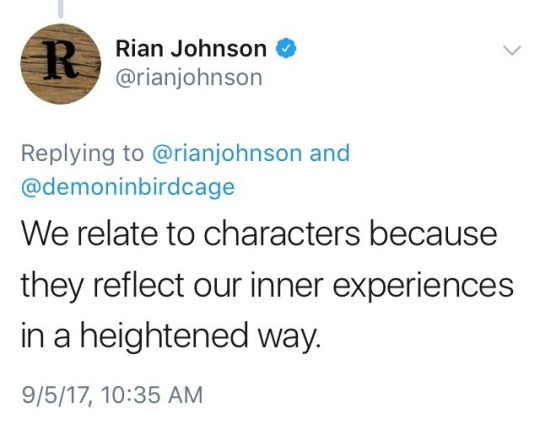
That's why the opening scene of the Last Jedi is so effective in getting the audience invested in the stakes of the film. Rian Johnson said that “Star Wars wasn’t about space ships but about the people inside the space ships.” Because while it's really hard for an audience to care about “the galaxy” being at stake if the heroes lose. When a movie gives us character's that we can connect with and relate to, then it makes it easier for the audience to care. For example, I care about what happens to the resistance because Rose is part of the resistance and I care about Rose because Rose lost her sister and clearly loved her, I can relate to this idea because I have two sisters and would be devastated if anything happened to them.
I think this human element is what makes memorable and inspiring films.
No film illustrates this concept of the emotional connection between the characters and the audience better to me than one of my favorites, “Saving Mr. Banks.” (Which also just so happens to be about writers misunderstanding a redemption story and is also a Disney movie)

“She's as real as can be to my daughters. And to thousands of other kids. Adults, too.” - Saving Mr. Banks (2013)
In fact, studies have shown that the relationships that we feel for fictional characters are very real and we can feel very strong emotions for them. “The interesting thing is that our brains aren’t really built to distinguish between whether a relationship is real or fictional, So these friendships can convey a lot of real-world benefits.” Those can include self-esteem boosts, decreased loneliness and more feelings of belonging.”- Jennifer Barnes (Assistant Professor of Psychology at the University of Oklahoma)
This is why fiction can feel like such a personal and intimate experience. I find it interesting that the writers of “The Force Awakens”, chose to make the villain of the series the son of Han and Leia two characters that audiences growing up watching the original trilogy loved and connected with. What is interesting is that OT Audiences are now Han and Leia’s age in the sequel trilogy and many have their own adult children. I believe that this was done intentionally because the audience is suppose to feel sympathy for Ben and see him as “their own child” in a sense. The audience is suppose to consider “what if this was my own child and they were struggling? What would I want to happen to them?”
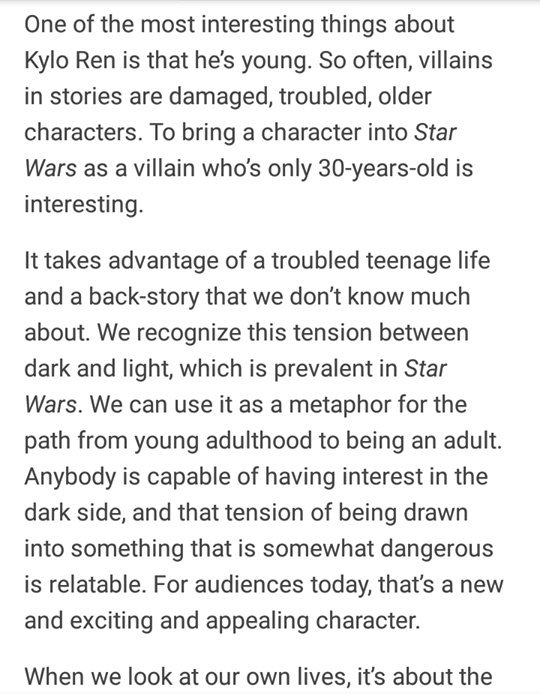
And that is why I can’t support this interpretation of Leia’s character:
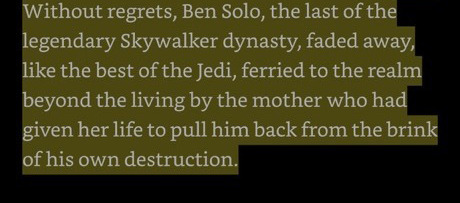
“Why did you have to make him so cruel? He was not a monster! You all have children, yes? And do those children make letters for you? Do they write letters? Do they make you drawings? And would you tear up those gifts in front of them? It's a dreadful thing to do. I don't understand. Why must Father tear up the advertisement his children have made and throw it in the fireplace? Why won't he mend their kite? Why have you made him so unspeakably awful? "In glorious Technicolor"? "For all the world to see"? If you claim to make them live, why can't he... they live well?”-Saving Mr. Banks (2013)
I can't view Ben's death as this hopeful positive thing that they've been trying to portray it as. Parents want what is best for their children, they want to see them succeed. What parent wishes for their child's death? Especially after he's just found hope. Now that they've “seen the light” wouldn't you want them to live their life to the fullest?
“I swear that every time a person goes into a movie house – from Leicester Square to St Louis, they will see George Banks being saved. They will love him and his kids, they will weep for his cares, and wring their hands when he loses his job. And when he flies that kite, oh! They will rejoice, they will sing. In every movie house, all over the world, in the eyes and the hearts of my kids, and other kids and their mothers and fathers for generations to come, George Banks will be honored. George Banks will be redeemed. George Banks and all he stands for will be saved. Maybe not in life, but in imagination. Because that’s what we storytellers do. We restore order with imagination. We instill hope again and again and again.” - Saving Mr. Banks (2013)
Star Wars has many themes, but the most prominent are redemption, compassion, family and most importantly of all... “Hope”
The reason we love redemption arcs is because they give us hope that anyone can change. They can inspire us to turn our own lives around and hope for a better future for ourselves and our family. The way TROS ends, with Ben’s death, creates a disconnect with the films message.

George Lucas believed that it was possible for lost people to find their way again and make a difference. But killing Ben Solo off after he’s done one good deed, goes against this message. If you want people to change, you have to let them live to correct their mistakes.
“Characters like Finn & Rey are examples of doing right. But you have to speak to the lost ones too if you want them to come home." -Unknown.
*Again I hope this makes sense, I have a lot of thoughts!
#ben solo#kylo ren#reylo#save ben solo#bring ben solo back#bring ben solo back alive#ben solo deserved better#ben solo deserves better#no one's ever really gone
162 notes
·
View notes
Photo

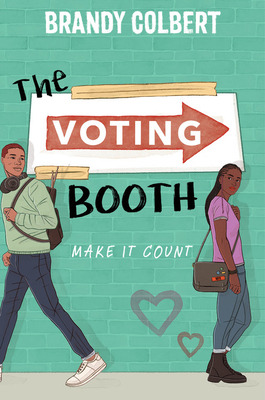



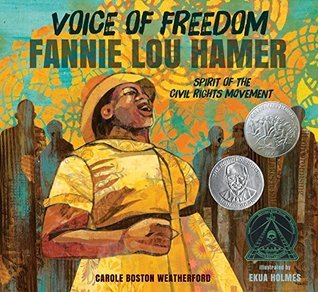

Voting and YA Lit
The November election is getting closer and closer. If you're eligible to vote and need more information, Vote.org is an excellent place to start. The League of Women Voters also has a First Time Voter Checklist that may be helpful. This year there may be additional challenges to voting, but if you are able, please let your voice be heard through your vote.
In the final two months before the election, you may enjoy some related reading. First, a few YA novels featuring elections or voting:
Yes No Maybe So by Becky Albertalli and Aisha Saeed Balzer + Bray [Group Discussion]
YES Jamie Goldberg is cool with volunteering for his local state senate candidate—as long as he’s behind the scenes. When it comes to speaking to strangers (or, let’s face it, speaking at all to almost anyone), Jamie’s a choke artist. There’s no way he’d ever knock on doors to ask people for their votes…until he meets Maya.
NO Maya Rehman’s having the worst Ramadan ever. Her best friend is too busy to hang out, her summer trip is canceled, and now her parents are separating. Why her mother thinks the solution to her problems is political canvassing—with some awkward dude she hardly knows—is beyond her.
MAYBE SO Going door to door isn’t exactly glamorous, but maybe it’s not the worst thing in the world. After all, the polls are getting closer—and so are Maya and Jamie. Mastering local activism is one thing. Navigating the cross-cultural romance of the century is another thing entirely.
The Voting Booth by Brandy Colbert Disney-Hyperion [Crystal's Review]
Marva Sheridan was born ready for this day. She’s always been driven to make a difference in the world, and what better way than to vote in her first election?
Duke Crenshaw is so done with this election. He just wants to get voting over with so he can prepare for his band’s first paying gig tonight.
Only problem? Duke can’t vote.
When Marva sees Duke turned away from their polling place, she takes it upon herself to make sure his vote is counted. She hasn’t spent months doorbelling and registering voters just to see someone denied their right. And that’s how their whirlwind day begins, rushing from precinct to precinct, cutting school, waiting in endless lines, turned away time and again, trying to do one simple thing: vote. They may have started out as strangers, but as Duke and Marva team up to beat a rigged system (and find Marva’s missing cat), it’s clear that there’s more to their connection than a shared mission for democracy.
Romantic and triumphant, The Voting Booth is proof that you can’t sit around waiting for the world to change, but some things are just meant to be.
Running by Natalia Sylvester Clarion Books
When fifteen-year-old Cuban American Mariana Ruiz’s father runs for president, Mari starts to see him with new eyes. A novel about waking up and standing up, and what happens when you stop seeing your dad as your hero—while the whole country is watching.
In this thoughtful, authentic, humorous, and gorgeously written novel about privacy, waking up, and speaking up, Senator Anthony Ruiz is running for president. Throughout his successful political career he has always had his daughter’s vote, but a presidential campaign brings a whole new level of scrutiny to sheltered fifteen-year-old Mariana and the rest of her Cuban American family, from a 60 Minutes–style tour of their house to tabloids doctoring photos and inventing scandals. As tensions rise within the Ruiz family, Mari begins to learn about the details of her father’s political positions, and she realizes that her father is not the man she thought he was.
But how do you find your voice when everyone’s watching? When it means disagreeing with your father—publicly? What do you do when your dad stops being your hero? Will Mari get a chance to confront her father? If she does, will she have the courage to seize it?
There are also a few YA nonfiction books that deal with activism and voting rights:
How I Resist edited by Maureen Johnson Wednesday Books
Now, more than ever, young people are motivated to make a difference in a world they're bound to inherit. They're ready to stand up and be heard - but with much to shout about, where they do they begin? What can I do? How can I help?
How I Resist is the response, and a way to start the conversation. To show readers that they are not helpless, and that anyone can be the change. A collection of essays, songs, illustrations, and interviews about activism and hope, How I Resist features an all-star group of contributors, including John Paul Brammer, Libba Bray, Lauren Duca, Modern Family's Jesse Tyler Ferguson and his husband Justin Mikita, Alex Gino, Hebh Jamal, Malinda Lo, Dylan Marron, Hamilton star Javier Muñoz, Rosie O'Donnell, Junauda Petrus, Jodi Picoult, Jason Reynolds, Karuna Riazi, Maya Rupert, Dana Schwartz, Dan Sinker, Ali Stroker, Jonny Sun (aka @jonnysun), Sabaa Tahir, Shaina Taub, Daniel Watts, Jennifer Weiner, Jacqueline Woodson, and more, all edited and compiled by New York Times bestselling author Maureen Johnson.
In How I Resist, readers will find hope and support through voices that are at turns personal, funny, irreverent, and instructive. Not just for a young adult audience, this incredibly impactful collection will appeal to readers of all ages who are feeling adrift and looking for guidance.
How I Resist is the kind of book people will be discussing for years to come and a staple on bookshelves for generations.
The March Trilogy by John Lewis, Andrew Aydin and Nate Powell Top Shelf Productions
A graphic novel memoir in three parts. It tells of the Civil Rights movement through the eyes of John Lewis. Readers see Lewis and other activists launching campaigns such as the Freedom Vote and Mississippi Freedom Summer. The books lead all the way through to the Selma March.
And finally, picture books aren't just for children. Here are two picture books young adults would likely appreciate:
The Voice of Freedom: Fannie Lou Hamer by Carole Boston Weatherford, illustrated by Ekua Holmes Candlewick Press
A stirring collection of poems and spirituals, accompanied by stunning collage illustrations, recollects the life of Fannie Lou Hamer, a champion of equal voting rights.
"I am sick and tired of being sick and tired."
Despite fierce prejudice and abuse, even being beaten to within an inch of her life, Fannie Lou Hamer was a champion of civil rights from the 1950s until her death in 1977. Integral to the Freedom Summer of 1964, Ms. Hamer gave a speech at the Democratic National Convention that, despite President Johnson’s interference, aired on national TV news and spurred the nation to support the Freedom Democrats. Featuring luminous mixed-media art both vibrant and full of intricate detail, Singing for Freedom celebrates Fannie Lou Hamer’s life and legacy with an inspiring message of hope, determination, and strength.
Granddaddy's Turn: A Journey to the Ballot Box by Michael S. Bandy & Eric Stein, illustrated by James Ransome Candlewick Press
Based on the true story of one family’s struggle for voting rights in the Civil Rights–era South, this moving tale shines an emotional spotlight on a dark facet of U.S. history.
Life on the farm with Granddaddy is full of hard work, but despite all the chores, Granddaddy always makes time for play, especially fishing trips. Even when there isn’t a bite to catch, he reminds young Michael that it takes patience to get what’s coming to you. One morning, when Granddaddy heads into town in his fancy suit, Michael knows that something very special must be happening—and sure enough, everyone is lined up at the town hall! For the very first time, Granddaddy is allowed to vote, and he couldn’t be more proud. But can Michael be patient when it seems that justice just can’t come soon enough? This powerful and touching true-life story shares one boy’s perspective of growing up in the segregated South, while beautiful illustrations depict the rural setting in tender detail.
69 notes
·
View notes
Link
Confirmation of Joe Biden’s election victory and his looming inauguration as the next President of the United States has elicited a joyful response from large swathes of the press and across social media. Yet for those people who are aware of Biden’s politics and record, beyond the spurious ‘nice guy’ image projected by the media, and therefore understand what the implications of his victory are likely to be, witnessing the mainstream reaction to it has been a profoundly alienating experience. This feeling of isolation has been exacerbated by the fact that legitimate criticism of Biden and his running mate, Kamala Harris, has frequently been met with personal invective, as though it is an attack on the very being of those who are currently celebrating their win.
As Devyn Springer has explained, ‘the gutting of political education and virality of capitalist miseducation means that people offering valid criticism, analysis, and reproval are likened to “hating” and “not letting people enjoy things” in the stunted Amerikan [sic] political imaginary.’ Lamentably, the absence of critical thinking and political imagination in the US is also a feature of political discourse in the UK. Contrary to the idea that feeling no joy regarding the prospect of a Biden-Harris administration is driven by a mean-spirited desire to spoil the happiness of others, it is in fact a sentiment that springs ultimately from love and solidarity – a crucial distinction that Steven Salaita recently expressed with characteristic eloquence. The inability to feel any joy at Biden winning, even if simultaneously relieved to see Trump lose, is borne out of compassion for all the past (and future) victims of both Biden’s personal actions, and of the neo-liberal and imperialist politics that he so perfectly embodies.
It should be plainly stated that by any meaningful and honest measure, Biden is a monster who has caused an incalculable amount of suffering over his many decades as a senior official of the US empire. Given the length of Biden’s career, a comprehensive rap sheet requires a book-length study, but his ‘highlights’ include his central role in drafting a number of deeply racist pieces of legislation (including the infamous 1994 Crime Bill) that both exacerbated and consolidated the mass incarceration of Black Americans, and legislation that went on to be passed largely unchanged as the Patriot Act of 2001 that gutted civil liberties in the US; his prominent role in lobbying the Senate and the American public for the war on Iraq as Chairman of the Senate’s Foreign Relations Committee; and his ‘unconditional, career-long commitment to Israel’ that has seen him develop close friendships with a number of fellow war criminals including Benjamin Netanyahu and the late Ariel Sharon, at whose funeral he delivered a eulogy. In short, Biden is a racist authoritarian at home and an enthusiastic and unapologetic imperialist abroad. On environmental issues, in spite of the hopes that liberals are already investing in him, Biden is little better. During the campaign he repeatedly announced that he will not ban fracking and his adviser on energy issues, who served as Energy Secretary under Obama, is a notorious lobbyist for the fossil fuel industry. It is alarming to note too that Ezekiel Emanuel, a member of Biden’s recently announced Coronavirus taskforce, has argued that life is not worth living beyond the age of 75.
In addition to the long list of sexual assault allegations he has faced, something that is rarely publicised or discussed outside of pro-Trump media, is the deeply disturbing fact that even when the cameras are rolling, Biden appears to be incapable of not smelling, kissing, groping and otherwise acting wildly inappropriately with women and girls with whom he comes into contact. Such is the incredible power of the media to continually re-invent and sanitise public reputations, that virtually all of this lamentable record is simply cast aside and intentionally obscured. Instead, Biden is regularly portrayed in a highly favourable light as a ‘decent, empathic man’ who supposedly stands in stark contrast to Trump. The truth, as articulated plainly in a recent interview by Evo Morales – the former President of Bolivia deposed in a US coup in November 2019 – there is really little difference between the two men and the parties they represent, except for that Trump’s racism and fascism is more explicit. All this does not even address the other elephant in the room: namely that Biden is evidently undergoing some form of cognitive decline, which, on multiple occasions throughout the campaign period, has left him unable to form coherent sentences and repeatedly slurred basic words and phrases.
It is telling, if not surprising, that many of those who have thus far publicly celebrated the election results with the most glee are those liberals who in their own words, cannot wait to stop caring about politics again. It was Trump’s overt racism, crude style and unpredictable theatrics on Twitter and elsewhere – the cause of such embarrassment to them and the US liberal establishment as a whole – that they opposed, not the actual content and results of his policies, so many of which were in fact a direct continuation of policies inherited from the Obama-Biden Administration, including the caging of migrant children and the much-derided ‘Muslim ban’. In fact, Trump’s recognition of Jerusalem as the capital of Israel, one of his most criticised decisions internationally, was only legally possible as a result of earlier legislation that Biden himself voted for and was later supported by Obama. It is evident that for many of those who formed the so-called ‘resistance’ to Trump, their opposition to his presidency was not driven by the harm that it inflicted, but rather by the damage it caused to America’s reputation globally and the subsequent embarrassment and discomfort they felt.
A widespread concern among elements of the US establishment, especially early on in Trump’s Presidency, was that he would make good on some of the anti-war rhetoric he had occasionally deployed during his campaign and not be sufficiently imperialist in outlook. It is for this reason that Trump received perhaps the most unanimously positive coverage in the media on the day on which he authorised air strikes on Syria. No such fears exist with Biden, who, as though such reassurance was required, has repeatedly gone out of his way during the campaign to demonstrate his hawkish credentials on a host of foreign policy issues including his stance on China, Syria and Iran. Accordingly, The Guardian has already called on Biden to ‘reassert America’s role as the global problem-solver’ because under Trump ‘the “indispensable nation” disappeared when it was needed most.’ A sentiment that is a perfect illustration of John Pilger’s maxim that ‘the task of liberal realists is to ensure that western imperialism is interpreted as crisis management, rather than the cause of the crisis and its escalation.’
In essence, liberals are fawning over Biden solely by virtue of him not being as obscenely and openly racist as Trump. To do so in spite of his disastrous record and in the absence of him running on any meaningful policy platform or alternative vision brings to mind C. Wright Mills’ scathing assessment of liberalism from his work The Marxists (1962), which is relevant enough to quote at length:
“As a set of theories – or better, of assumptions about man, society, history – liberalism today is at a dead end. The optative mood has so thoroughly taken over that liberals often appear out of touch with the going realities. That is one reason it is so difficult to sort out distinctively liberal theories as such. Often failing to recognize facts that cry out to be recognized, liberalism is irrelevant to much that is happening in much of the world. Liberal ways of looking at these facts too often become mannerisms by which liberals avoid considering the structural conditions of social life and the need to change them. In fact, liberals have no convincing view of the structure of society as a whole – other than the now vague notion of it as some kind of a big balance. They have no firm sense of the history of our times and of their nation’s.”
Under Trump’s leadership, most notably at the height of the vicious repression of the Black Lives Matters protests in May and June of this year, the superficial mask of American liberalism dropped entirely, exposing the ugly fascism at its core. Biden’s win is undoubtedly the start of a concerted effort to lift that mask back up, restore America’s image and get back to the business of imperialism disguised as ‘global problem-solving’. Trump’s overt racism will be replaced with the more refined, tacit variety at which the Democratic Party excels, and his candid admissions regarding the true motivations behind US military action substituted with statesman-like messaging about humanitarian intervention and the international community’s ‘responsibility to protect’. That Biden’s Vice-President will be Kamala Harris, a half Black, half South Asian-origin woman – regardless of the fact her politics are as reactionary as his – will also be used to project an ostensibly progressive image of the incoming administration. All those who are committed to opposing all forms of racism and imperialism, of the refined variety or otherwise, must resist these dishonest attempts to portray a Biden win as anything more than an administrative reshuffle within the bi-partisan management of a genocidal empire that, whoever is President, represents a grave danger to its own people and the future of everyone else on this planet.
5 notes
·
View notes
Text
Artistic Swimming: Full Team Event from Rio 2016 || A Sports Analysis

Artistic swimming is a hybrid form of swimming, dance, and gymnastics, consisting of swimmers performing a synchronized routine of elaborate moves in the water, accompanied by music. Artistic swimming is governed internationally by FINA or Fédération internationale de natation (English: International Swimming Federation) and has been part of the Summer Olympics program since 1984. Also, Artistic swimming demands advanced water skills, requires incredible strength, endurance, flexibility, grace, artistry, precise timing, and exceptional breath control when upside down underwater. Competitors show off their strength, flexibility, and aerobic endurance required to perform complex routines (Bhutia, 2017).
Today’s blog will focus on a Full Team Event from Rio 2016, specifically the sport Artistic Swimming. This analysis will also consist of the court dimensions, equipment, basic skills, technical and tactical skills of each team, rules of the sport, officials, and the overall performance.
youtube
Court Dimensions

The pool must be at least 20m wide x 30m long and at least 2.5m deep. One area, 12x12m or more extensive, must be at least 3m deep, and the slope between the change in depths has to be completed over a distance of 8m or less.
The pool's water must be clear enough so that the pool's bottom is visible from above and at least 27°C (80.6°F) plus or minus one degree. The amount of light underwater is also significant since goggles aren't worn in competition, so there is a required minimum brightness of 1500 lux.
Equipment

Nose Clip
It is a small wire clip coated in plastic that prevents water from entering the sinuses during underwater movements. Nose clips, or some apparatus to prevent water from rushing into the nostrils, are essential to synchronized swimmers, often inverted and spinning around with their heads submerged for extended periods.
Costumes
The rules of synchronized swimming's governing body (FINA) indicate that costumes must be appropriate for a sporting event and must not be transparent. No other clothing or accessories, including goggles, are allowed unless required for medical reasons. Competitors often wear colorful and tastefully decorated suits with coordinated hair/head adornments. The equivalent of stage makeup is applied to enhance appearances as seen from a distance by the judges and audience. The style of the costumes chosen should work well with the choice of music and style of choreography.
Underwater Speakers
The essential equipment for synchronized swimming is the underwater speakers. Swimmers cannot perform underwater if the music is not audible. Music plays a vital role in synchronized swimming because it is a rhythmic sport.
Hair Gel
Hair gel or gelatin is an essential aid to keep swimmers' hair neat and out of the way while performing. The hair is tied back securely and plastered down with some substance.
Basic Skills
Breathing

This is a frequently overlooked essential skill, but it is an important one since oxygen is necessary for everyone. Athletes in artistic swimming need to have their breathing skills to execute their performance well enough. Moreover, proper breathing provides many benefits to the athletes since it can help with how they swim and how they move their bodies. If proper breathing is well-executed, it can add resistance to the body's stroke and fatigue.
Floating

Floating helps a person to get used to the habit of moving through water properly. Floating helps to keep the body on the surface of the water. When immersed in water and floating, a person's body experiences a vertical buoyant force to keep the body in a horizontal position. Floating is essential because this makes an athlete stay in the water, especially one of the rules of artistic swimming is not to touch the floor.
Body Coordination

In swimming, all the body parts should be well coordinated with each other. A person must be able to move the muscles of their lower back, abdomen, and hips in a synchronized way to keep moving forward. The hands should move and cut through the water first, followed by the elbow, and then your body should make way through the water.
Strokes

Strokes are the arm movements that help to pull the body through the water. The front crawl, sidestroke, backstroke, and butterfly are some of the standard swimming strokes.
Sculling

Sculls are a hand movement that is used to propel the body, and it is an essential part of the Synchronized Swimming performance. The commonly used sculls are the paddle scull, split-arm, scull, barrel scull, standard scull, torpedo scull, and support scull. The support scull is performed to support the body when a swimmer is performing upside down. It is performed by holding the upper arms against the sides of the body and the lower arms. The arms remain at the 90-degree angle. This allows the swimmer to control his/her legs above water level when he/she is swimming.
Egg Beater

The Eggbeater is a kick in the Synchronized Swimming. It allows the performer to stabilize themselves while having a height above the water level and leaving the hands free to perform strokes. An average height for an eggbeater is around chest level. With this skill, the swimmers can also perform boosts to use their legs to push themselves out of the water level on their hips or even higher.
Lifting

Lifts are formed underwater, and as swimmers propel themselves towards the surface, they stay in formation and add more elements like acrobatics. The following are the three parts to a lift in artistic swimming and the types as well:
The Flyer - Flyers are agile and flexible and are usually the smallest member of the team. They should have a gymnastics background as they need to perform complicated moves while on the top of the formation.
The Base - Base swimmers tend to be small in size but should have good leg strength and a solid core as they make up the formation structure.
The Pushers - Pushers are the bigger and stronger swimmers because they need the strength to propel the water surface formation.
Types of Lifts
1. The Platform Lift - The base lays out in a back layout position underwater, where they lie on their back to form a platform of interlinked bodies. The Flyer sets in a squatting place and stands once the lift reaches the surface. The remaining teammates use the eggbeater kicks to hold the platform and the flyer out of the water.

2. The Stack Lift - Considered to be an updated version of the Platform, the Stack Lift begins with the base squatting while underwater, supported by the pushers. The flyer then stands on the shoulders of the base. The pushers and base gradually stretch out their limbs, elevating the flyer. A rotating descent is usually added to this lift.

Positioning

This helps the athletes balance at the same create beautiful stunts to showcase it to their audience. There are hundreds of positions that can be used to create infinite combinations. The six most common positions are illustrated below.
Crane Position - Hold your body in a vertical position with one leg held vertically above the water surface, while the other leg is held parallel under the surface in a 90-degree angle or "L" shape.
Ballet Leg Double Position - From lying flat on the water surface, draw your knees towards your chest with shins parallel to the water surface. Straighten your legs above the water surface to assume a Surface Ballet Leg Double position.
Side Fishtail Position - This is a position similar to the crane. One leg remains vertical, while the other is extended to the side parallel to the water, creating a side "Y" position.
Knight Position - The body is held vertically with your head in line with the hips and pointed to the pool's bottom. One leg is lowered to create a vertical line perpendicular to the surface.
Flamingo Position - Similar to the ballet leg position where the bottom leg is pulled into the chest so that the shin of the bottom leg is touching the knee of the vertical leg.
Split Position - With the body vertical, one leg is stretched forward along the surface and the other leg is extended back along the surface.
Technical and Tactical skills of Each Team
EGYPT

Despite being the youngest out of all of the teams (age ranging from 17 to 20), their synchronization is a must, and their formation was good, showing that they have practiced well. I had a hard time knowing the theme of their performance, but all in all, they did great and showed their execution through the song from the Lion King. Besides, they also used all the necessary skills to complete their performance.
AUSTRALIA

The music they have used was smooth, then it turns into rough and rugged upbeat music to which their advantage since it the very beginning they have shown an artistic start. To me, they looked liked swans showing how flexible and elegant they are at the same time. Their performance showed quite a story to the audience. Moreover, they have stunts that were excellent to the viewer and made them stare enough.
ITALY

Their theme was the Season on Earth and what I like about it is their expression from the very start of the show before they dive in the pool. They have shown tremendous balance and incredible strength. The way they changed their movements is smooth, and they have good synchronization. Their formation can't be broken in which what their formation is; that indeed is their formation. For example, the formation from a circle to a diagonal to which their formation transitions were also good. To top it all, they end it with soft music same as how they start their show.
BRAZIL

This team showed how lively they are from the beginning. Their smiles were so broad in welcoming the audience, and the song they chose was active and in beat to which I love since it showed and expressed their country. At the same time, they have demonstrated a lot of spirit throughout the show. Moreover, they're more on succession, and the balance on the feet was terrific. Like Italy, Brazil also does their movement quickly and have a good synchronization. Also, I like how their lifts are made using the water to have the extra splash, which can be found in 30:52 in the video. This team is also risk-takers since it was pretty seen that there many complicated and high risks stunts and movements to their performance.
RUSSIA

This team is what I like the most since despite them being the defending champion, they have gained the audience's attention through their stunts and movements. Their theme was Angels, to which they have used their hands and legs to show their wings. With these, they looked like ballerinas in the pool dancing around and showed how elegant they are. Moreover, their song was a fast beat at the start, and sometimes throughout the performance, it became slow then fast again. Their performance started with a high stunt which was I can say was an incredible start and end it with a twirling action. Also, their legs were compatible with one another showing almost the same height as their legs. Their lifts and the balance were so good that it made me awe, especially the stunt that can be found in 37:18, and all of their lifts were high-degree ones. All in all, they have shown excellent and tremendous synchronization, flexibility, energy, power, and acrobatic moves.
UKRAINE

This team has the theme of Illusionism in the Magic Box and reflects one another throughout their performance. There was a lot of originality in it, and like Russia, they also have the same start in which they made a lift but have a more complex one than Russia. Moreover, what truly gained my attention was the high risk when an athlete steps up in the back of the other athlete and still showed her style with an impact. This team has many similarities with Russia since both of them have the same length with the legs, and they have a lot of beautiful spins. Moreover, their successions were so fast and still able to show it well. The strength of these athletes showed throughout their performance.
CHINA

This team showed their tradition in which they express their dance-like how a dragon moves. They have an excellent interpretation of the song. Simultaneously, they started their performance with a fierce look and showed a high-degree rugged stance with many spins. It showed how much power this team has since they showcase many complicated moves that need complete precision. Also, they are quick in changing formation showing no rest at all on their movements and stunts. I can say that their strategy is more on speed to which they were fast, which for me was hard to synchronize, but they make it as easy as it sounds since they did well. Overall, their performance was breathtaking, and end the show with a claw pose.
JAPAN

This team showed their theme was the Dawn Start of the New Glory Towards of the Sun and had happy upbeat music. Like other teams, they also start with an incredible stunt and have a lively performance. Their moves were more symmetrical and accurate. The lifts and sculls were good in that they were very synchronized and have shown elegance while doing a steady lift. Their performance was lively and was remarkably enjoyable to finishing the event.
Rules of the Sport
Swimmers and teams must qualify for the Olympic competition at other, earlier competitions. Once at the Olympic games, there are two events contested in synchronized swimming, team and duet. Within each of those events are two routines, a technical and a free routine. Since the video showed that it was a free routine, then it has no requirements so the swimmers can be ‘free’ in how creative they get with the movements and their choreography. Below are the basic rules of the sport:
1. Eight swimmers on a team
2. One alternate swimmer
3. 4:00 time limit ( + or -15 seconds)
4. Perform a self-choreographed routine with no specific requirements
5. No Touching The Bottom
One of the things which makes the lifts all the more impressive is that artistic swimmers are not allowed to touch the bottom of the pool at any point during their routines.
6. No Bling
Presentation is a unique and important part of artistic swimming but there are certain restrictions on what swimmers can wear. For example, artistic swimmers are not permitted jewelry, theatrical make-up, or inappropriate costumes.
7. No Goggles
Another restriction during artistic swimming routines is goggles. However, swimmers in figures competitions are permitted to wear them.
8. Team Means Team
Teams normally contain eight swimmers, but the minimum number for a team is four. Teams lose marks for every swimmer they have under the full complement because it is easier to synchronize the fewer people there are in a routine.
9. Stick To The Schedule
Routines can be anything from two and a half minutes to five minutes long, depending on whether they are performed alone or as part of a team. However, swimmers are penalised if they take 15 seconds fewer or longer than the specified time.
Scoring and Judging
Scores are given by the judges are on a scale from 0 to 10, in tenth-of-a-point increments. 10 is the perfect score. In the figures event, judges evaluate design and control. The design of a figure is determined by the accuracy of the positions and the correctness of the transitions between those positions. Control includes extension, height, stability, and an even tempo.
After all of the judges submit their routine scores, the high and low numbers are dropped. Then, the scores from each category are added together get the composite score. At some competitions, medals are awarded for technical routines and free routines, but usually both scores are combined for the final ranking.
Officials
Timekeeper
A timekeeper's role is to check and record the overall times of the routines and the deck movements. If the time limit for the deck work is exceeded or there is a deviation from the permitted routine time allowance, the timekeeper advises the referee.
Clerk of the course
A clerk of the course's role is to organize the competitors so that they are ready for their events at the required time. During figure competitions, they ensure that the swimmers are in the correct order to perform their figures.
Scorer
A synchro scorer's role is to record marks from the judges and make the necessary computations for each routine. There are two levels of synchro scorer – national scorer and chief recorder. National scorers write down and manipulate all the scores that come in for figures and routines at competitions. Chief recorders are in charge of scoring at synchronized swimming events. They are trained to manage related computer results systems at national and regional competitions.
Judges
For free routines, three are three panels consisting of Executions Jury, Impression Jury, and Element Jury. For technical routines, judges evaluate the performance based on execution and overall impression.
Execution Jury is more on execution and synchronization. Impression Jury is more on the artistic impression in which they judge the choreography, interpretation of music, and presentation manner. The manner of presentation is evaluated on the appearance of capability and effortlessness. Lastly would be the Element Jury, where they judge the amount of difficulty.
Sound Center Manager
Sound Center Manager is entirely responsible for the correct execution of the music. Coaches are responsible for submitting their music electronically via the Internet to the Sound Center Manager according to the instructions in the Meet Announcement to prepare the music.
Overall Performance

All in all, I admired all the athletes that showed their performance. They have their different themes and style to which they got the attention of the audience or viewer. After watching, I can say that I was amazed at what they have showcased to us. Being part of artistic swimming is very difficult since you have to swim like a professional and you have to be fast. Those acrobatics that they have shown takes time to learn. They have to be perfectly executed and choreographed. Everybody has to be synchronized and well-trained. This indicates that it is one of the most challenging sports out there; that's why I admire it so much. These athletes deserve more recognition and respect.
Moreover, the one who goes the first place out of eight teams was Russia. They were the champion before and still got the gold medal now. They have showcase what they truly wanted to convey and won first place.
Bibliography
An introduction to artistic swimming. (n.d.). Retrieved March 24, 2021, from Swim England Artistic Swimming: https://www.swimming.org/artistic-swimming/introduction-to-artistic-swimming/
Basic skills and positions in Synchronised Swimming. (n.d.). Retrieved March 24, 2021, from My Active SG: https://www.myactivesg.com/Sports/Aquatics/How-To-Play/Synchronised-Swimming/Basic-skills-and-positions-in-Synchronised-Swimming
Basic Skills required for Synchronized Swimming. (n.d.). Retrieved March 24, 2021, from Sportycious: https://sportycious.com/basic-skills-required-synchronized-swimming-91536
Bhutia, T. K. (2017, December 3). Synchronized swimming. Retrieved March 24, 2021, from Britannica: https://www.britannica.com/sports/synchronized-swimming
Lutz, R. (2016, July 22). Synchronized swimming 101: Equipment. Retrieved March 24, 2021, from PyeongChang 2018: http://archivepyc.nbcolympics.com/news/synchronized-swimming-101-equipment
Officials in synchro. (n.d.). Retrieved March 24, 2021, from Officials in synchro: http://edinburghsynchro.co.uk/officials-in-synchro/
Synchronized Swimming Pool Dimensions. (n.d.). Retrieved March 24, 2021, from Swim Outlet: https://www.swimoutlet.com/guides/synchronized-swimming-pool-dimensions#:~:text=The%20pool%20must%20be%20at%20least%2020m%20wide%20x%2030m,distance%20of%208m%20or%20less.
Synchronized Swimming Rules & Regulations. (n.d.). Retrieved March 24, 2021, from SwimOutlet: https://www.swimoutlet.com/guides/synchronized-swimming-rules-regulations
1 note
·
View note
Text
Fur and flesh to metal and fire: Native woman as embodiment of cultural tradition and anti-colonial re-configurations of steampunk in “Good Hunting”
Introductory note
I’ve seen tumblr posts and opinion pieces praising and condemning the animated adaptation of Ken Liu’s “Good Hunting” in Love, Death + Robots. Whether positive or negative, most comments are brief and reactionary, with some expressing awe towards the steampunk and Chinese folklore elements, and/or disappointment towards its depictions of sexual and racial violence. I’m writing this post as an appeal for viewers and readers to consider the centrality and depth of European colonialism to the narrative, and attempt to interpret the story’s denotations on the dynamics between the European colonizer, the colonized man, and woman in the aftermath of the Opium War. This post draws heavily on Ken Liu’s original text in addition to the Netflix adaptation.
Summary:
The gendered Chinese folklore of the Huli jing and Good Hunting’s subversion
Colonial British “progression” (in the form of steam tech) displaces Chinese folklore
The Body is Political – conquest of body and land
The Empire’s Subjects Strike Back – Re-programming steampunk for decolonial resistance
Personal evaluations on adapting text to film
The gendered Chinese folklore of the Huli jing and Good Hunting’s subversion
The text introduces the huli jing as a figure of Chinese folklore: one that, like the succubus of the West, is a predatory female that seduces and preys on men. It is a folklore that reflects male anxieties of the dangers and dirtiness of female sexuality:


[1]
“You must save him,” the merchant’s wife had said, bowing like a chicken pecking at rice. “If this gets out, the matchmakers won’t touch him at all.” [2]
The huli jing is a figure heavily entrenched in the Chinese psyche as promiscuous, immoral, and sexually devious, to the extent that it even permeates the language: “huli jing” is widely used today as an insult against sexually deviant women (usually against 小三 / 3rd party / side woman, like slut / bitch). Liu’s depiction is thus very explicitly and purposefully subversive in its attempt to give the huli jing a voice, to testify to their innocence (or at the very least, blamelessness):
“She liked her freedom and didn’t want anything to do with him. But once a man has set his heart on a hulijing, she cannot help hearing him no matter how far apart they are. All that moaning and crying he did drove her to distraction, and she had to go see him every night just to keep him quiet.”
This was not what I learned from Father.
“She lures innocent scholars and draws on their life essence to feed her evil magic! Look how sick the merchant’s son is!”
“He’s sick because that useless doctor gave him poison that was supposed to make him forget about my mother. My mother is the one who’s kept him alive with her nightly visits. And stop using the word lure. A man can fall in love with a hulijing just like he can with any human woman.” [2]
Liu makes his intentions clear in the comment:
In writing this story, I wanted […] to turn the misogynistic huli jing legends upside down. In these legends, usually composed by male scholars, the huli jing is a dangerous feminine creature who uses her sexuality to deprive men of their vitality and essence. My huli jing questions that narrative. [3]
Following Yan’s appeal and the brutal death of her mother, the protagonist Liang and the viewer/reader alike become convinced of her innocence and the huli jing‘s victimhood – we become aligned with her. And indeed, the text seems to unite the native Chinese characters and folklore across gendered and human/demon fault lines against the greater threat of foreign colonizers.
Colonial British “progression” (in the form of steam tech) displaces Chinese folklore
The narrative is set in the aftermath of the Opium War, and the British occupation of Hong Kong (around 1841). Though Yan and Liang reside in a more rural area, the British presence is strongly felt, mainly through the steam trains and railways that come to penetrate the landscape:
I had heard rumors that the Manchu Emperor had lost a war and been forced to give up all kinds of concessions, one of which involved paying to help the foreigners build a road of iron. But it had all seemed so fantastical that I didn’t pay much attention. [2]
The train is widely presented as a symbol of modernity that the “progressive” British colonizers attempt to bring to their “backward” colonies in their civilizing mission [4]. The “advancement” of the steam train is clearly antagonistic to the “primitive” native religion – they cannot coexist, and with colonization, the occupier’s system of logic, truth and tech displaces native belief, practice and magic:
Thompson strode over to the buddha and looked at it appraisingly. […]
Then I heard a loud crash and a collective gasp from the men in the main hall.
“I’ve just broken the hands off of this god of yours with my cane,” Thompson said. “As you can see, I have not been struck by lightning or suffered any other calamity. Indeed, now we know that it is only an idol made of mud stuffed with straw and covered in cheap paint. This is why you people lost the war to Britain. You worship statues of mud when you should be thinking about building roads from iron and weapons from steel.”
There was no more talk about changing the path of the railroad.
After the men were gone, Yan and I stepped out from behind the statue. We gazed at the broken hands of the buddha for a while.
“The world’s changing,” Yan said. “Hong Kong, iron roads, foreigners with wires that carry speech and machines that belch smoke. More and more, storytellers in the teahouses speak of these wonders. I think that’s why the old magic is leaving. A more powerful kind of magic has come.” [2]
Note the privileging of the new and inorganic (roads of iron, weapons of steel) over the old and organic (statues of mud and straw) – the landscape (and later, Yan’s organic body) transforms in this manner. Yan details how the changes affect her: she can no longer transform at will, and barely hunts enough for survival.



Liang is likewise affected. The text explains his decision to leave for British-administered Hong Kong: colonization renders his family’s demon hunting business obsolete, and his father takes his own life:
People stopped coming to Father and me to ask for our services. They either went to the Christian missionary or the new teacher who said he’d studied in San Francisco. Young men in the village began to leave for Hong Kong or Canton, moved by rumors of bright lights and well-paying work. […] As I let his body down, my heart numb, I thought that he was not unlike those he had hunted all his life: they were all sustained by an old magic that had left and would not return, and they did not know how to survive without it. [2]
Regardless of their previous antagonism, human and demon, man and woman alike are dispossessed by colonialism. For the native woman especially, this colonial invasion is particularly intimate, as it occurs at the level of the sexual.
The Body is Political – conquest of body and land
I believe that Good Hunting illustrates how the native woman embodies the culture of the colonized, and thus her body becomes a site of political and sexual contestation. I base this belief on notions from Frantz Fanon’s essay, “Algeria Unveiled”, in which he describes the psycho-sexual antagonism arising between the white French colonizer and the veiled Muslim women of Algeria. Needless to say, real-life accounts differ from fictive re-imaginings, and the cultural configurations of French Algeria and British Hong Kong are definitely inequivalent, yet, they share common rhythms in the dynamic of sexual violence between white colonizer and the exoticized colonial subject.
Fanon explicates how the veiled Muslim woman’s body came to represent the whole culture of the colonized peoples of Algeria:
One may remain for a long time unaware of the fact that a Moslem does not eat pork or that he denies himself daily sexual relations during the month of Ramadan, but the veil worn by the women appears with such constancy that it generally suffices to characterize Arab society. We have seen that on the level of individuals the colonial strategy of destructuring Algerian society very quickly came to assign a prominent place to the Algerian woman. The colonialist’s relentlessness, his methods of struggle were bound to give rise to reactionary forms of behavior on the part of the colonized. In the face of the violence of the occupier, the colonized found himself defining a principled position with respect to a formerly inert element of the native cultural configuration. [5]
In short, the veil, a “formerly inert element” of Algerian Muslim culture, gains significance because it becomes a marker of that culture, a marker of difference, under the white colonizer’s gaze. To eliminate native culture, it is therefore imperative to eliminate the veil, and the native Algerian reacts by resisting this unveiling. In this manner, the Algerian woman’s body becomes a site for colonial conflict. This is why imperial expansion and territorial conquest is inextricably tied to rape – think of the pervasiveness of “rape and pillage”:
The history of the French conquest in Algeria, including the overrunning of villages by the troops, the confiscation of property and the raping of women, the pillaging of a country, has contributed to the birth and the crystallization of the same dynamic image. At the level of the psychological strata of the occupier, the evocation of this freedom given to the sadism of the conqueror, to his eroticism, creates faults, fertile gaps through which both dreamlike forms of behaviour and, on certain occasions, criminal acts can emerge. Thus the rape of the Algerian woman in the dream of a European is always preceded by a rending of the veil. We here witness a double deflowering. [5]
Thus, it is at this site of sexual contestation of the woman’s body that struggle and resistance takes place. To me, Fanon’s conflation of the woman’s body to the native land and culture allows us to better understand Good Hunting. Yan’s identity as a huli jing already presents her as an embodiment of Chinese “old magic”. With British industrialization and influence, Chinese magic is quelled, and Yan loses her powers, symbolizing the disempowerment of Chinese culture.
As colonial steam technology dominates the landscape, native magic weakens, as does Yan’s body. The violence exacerbates when the characters migrate to the centre of colonial administration – Victoria Peak in Hong Kong. Here, there is a gendered difference in the way Liang and Yan are brutalized. Liang’s engineering talent is discounted – the native’s labour is exploited and undervalued.
“Are you the man who came up with the idea of using a larger flywheel for the old engine?”
I nodded. I took pride in the way I could squeeze more power out of my machines than dreamed of by their designers.
“You did not steal the idea from an Englishman?” his tone was severe.
I blinked. A moment of confusion was followed by a rush of anger. “No,” I said, trying to keep my voice calm. I ducked back under the machine to continue my work.
“He is clever,” my shift supervisor said, “for a Chinaman. He can be taught.”
“I suppose we might as well try,” said the other man. “It will certainly be cheaper than hiring a real engineer from England.” [2]

This is immediately followed by a scene of British clients sexually harassing Yan, now a sex worker.

The dialogue deliberately frames their subjugation as racialized. Liang adapts to colonial Hong Kong but he is not a part of it – he becomes educated in the technical language of the colonizer, replacing his inherited knowledge of magic with that of steam, but his racial difference is constantly referenced (perhaps he’s “white but not quite” [6]). He is a “Chinaman” regardless of ability and any attempt at assimilation. This discrimination occurs in the capacity as employer-employee, master-servant, at the meeting point of the train operations room, the workplace. For the native woman, due to the colonial sexual appetite – the tradition of rape and pillage – violence occurs at the intimate meeting point of her body, on which white expectations of her race are burdened – note how the stereotype of Chinese industriousness is used to pressure her into sexual labour. The colonizers feel entitled to the servitude of both native bodies – the man’s labour, and the woman’s sexual subjugation.
The text notes that this violent encounter leading to Yan and Liang’s reunion happens on a culturally significant date:
“Don’t let the Chinese ghosts get you,” a woman with bright blond hair said in the tram, and her companions laughed.
It was the night of Yulan, I realized, the Ghost Festival. I should get something for my father, maybe pick up some paper money at Mongkok. […]
“It’s the night of the Ghost Festival,” [Yan] said. “I didn’t want to work any more. I wanted to think about my mother.”
“Why don’t we go get some offerings together?” I asked. [2]
Similar to Día de Muertos – the Mexican Day of the Dead – the month of the Hungry Ghost Festival is a time to remember and honour the deceased. It is believed that the gates of the underworld open during the seventh lunar month, and the spirits of the departed return to visit the living. We follow Liang’s thoughts as he realizes it is the night of Yulan, and immediately encounter Yan, which might suggest to us that she is a ghost of sorts coming back to haunt him – she represents an old culture, dead or dying. The story connects the violent encounter, the sexual degradation of Yan’s magic-drained body, to the death of Yan and Liang’s parents, and maybe even the death of Yan herself. Colonial violence corresponds to the death of native culture.
To further cement this idea that the colonized woman’s body is conflated to the land, Yan’s body comes to receive the ultimate abuse from the figure of the governor (or the governor’s son, in the original text). Her sexual perpetrator is not an everyman, but the political representative of the British colonist; where Yan embodies native Chinese culture, her rapist embodies the British colonial administration. He ravages and consumes her body as a colonizer takes and devours territory – I think the showrunners deliberately portrayed him as obese to evoke a grotesque image of imperialist greed and over-consumption of the colonies’ resource. (Of course, this has problematic real-life implications on public perceptions of fat people.) He takes her organic body apart and reconstructs her to his own fetish fantasy of steel and chrome – just as Britain fragments, reforms, reshapes China’s trade, opium economy, and territory (e.g. Hong Kong), to its own will.
Yan’s rape and reconstruction is thus conflated to the political conquest of China and Hong Kong. (Jameson’s notion of the national allegory comes to mind. [7])
The Empire’s Subjects Strike Back – Re-programming steampunk for decolonial resistance
In Good Hunting, the mode of S/F (= speculative fiction / science fiction / science fantasy) enables imagination of how the native can re-appropriate and re-configure the colonizer’s weapons against them. Ken Liu notes:
I think there’s a paucity of good steampunk that addresses the dark stain of colonialism in a satisfactory way. Like many of my stories, this tale has an anti-colonial theme. [Yan] says, at one point, “A terrible thing had been done to me, but I could also be terrible.” It is about as succinct a summary of the experience of being a member of a colonized population as I can give. [3]

A recognizable figure of Buddhism is shown before Liang and Yan move to Hong Kong, in the form of a Buddha statue. Yan is shown in the same frame bowing to it, aligning her with the natives’ religion and again, reinforcing her as a representative of native culture. The next encounter with a religious figure comes in the form of Guan Yin, and if the friend I consulted is not mistaken, it’s possibly the incarnation with 千手千眼 / “The One With A Thousand Arms and Thousand eyes”:

The buddha Amitābha, upon seeing her plight, gave her eleven heads to help her hear the cries of those who are suffering. Upon hearing these cries and comprehending them, Avalokiteśvara attempted to reach out to all those who needed aid, but found that her two arms shattered into pieces. Once more, Amitābha came to her aid and appointed her a thousand arms to let her reach out to those in need. [8]
This statue looks on, and takes up the entire frame as the rapist-governor cries out in pain offscreen while Yan attacks him with her new mechanized strength, her body no longer victimized but newly weaponized, declaring “I could also be terrible”. The Guan Yin statue frames Yan’s act as one of divine retribution – an individual woman’s rebellion that draws strength from a wider colonized peoples and their religion. Though her organic magic had been forcefully amputated and replaced with the colonizer’s inorganic steam tech, the image of Guan Yin suggests that the old culture is not dead, but reborn in a new incarnation, to deliver comeuppance.
(Personal disclaimer: it is with bitter irony that I must admit my estrangement from these figures – so feel free to add or counter this if you’re more well-informed on the significance of Guan Yin and Buddha here.)
As I’ve mentioned before, Liang’s proficiency in the colonizer’s language of technology functions as a means of his survival, but this same distancing and Othering of him by the colonists keeps him from fully aligning himself with them, and he readily repurposes his mechanical expertise for the antagonistic cause of rebellion, thus engineering not a steam train (weapon of British imperial expansion) but a huli jing (weapon of Chinese folklore and emasculation, albeit the target of emasculation has shifted). The same technology that drove out the magic is now used to empower that folklore.



In these acts of re-configuration, I see an endeavour to visualize how a threatened culture can survive and thrive in the future. Creators like Ytasha Womack emphasize how the S/F genre of Afrofuturism (emphasis on “future”) is necessary for black persons to imagine a future with themselves in it, to provide a vision of empowerment, possibility, and survival [9]. Good Hunting’s narrative, though more of an alternate history, similarly offers a positive possibility in which Chinese culture and mythology is not smothered by colonialism and technological change, but adapted to it:
The old magic was back but changed: not fur and flesh, but metal and fire. [2]
I would also tentatively speculate that perhaps this narrative of colonized man allying himself to empower colonized woman is also driven by an impulse (maybe underlying, at the level of the subconscious) to quell male anxieties of colonial domination and complicity in female subjugation – to re-imagine a history where the figure of the Chinese male is less of a passively helpless witness to sexual abuse, to his country’s subjugation, but an active agent able to empower her. In other words, it could be a case of ‘fantasy as coping mechanism for trauma’ – re-imagining the outcomes of a traumatic past such that the victim-survivor overcomes his abuser (in this case, I see it coming from a male perspective).
Finally, I think this ‘weaponizing the colonizer’s own tools against him’ works on a metafictional level as well: the English language has long been the medium and weapon of English / white supremacy. See Macaulay’s minute on education in which he basically appeals for Indian colonial subjects to be educated in Eng to transmit British ideas, modes of thinking, systems of thought [10]. English language and literature works to naturalize anglo-imperialist modes of reasoning, to colonize the imagination. I like to think that for Chinese-American Ken Liu to tell this story in English is a re-purposing of the language to bite back at the colonizer. And if we regard the steampunk trope as a playful British fantasy of Victorian-era aesthetics, Liu’s re-fashioning and appropriation of the trope – to infuse it with a tale of colonial vengeance – is akin to Liang and Yan’s appropriation of the colonizer’s own weapons. Liu’s act of writing Good Hunting may be exemplary of how “the empire writes back with a vengeance”, to quote Salman Rushdie [11].
Personal evaluations on adapting text to film
I find that the animated adaptation has a heavier “male gaze”, a term coined by film critic Laura Mulvey: mainstream cinema is a product of patriarchal institution, and most films assume the perspective of a male, while the female is configured onscreen as erotic object [12]. To borrow Linda Williams’ words, “the bodies of women figures on the screen have functioned traditionally as the primary embodiments of pleasure, fear, and pain” [13]. The animated adaptation appears more explicit in its spectacles of female nudity and victimhood, evident in the shots panning up Yan’s legs as a harasser raises a cane to lift her dress; over her struggling, restrained, unclothed body; and over her face contorted in fear and disgust. I’ve wondered if this is necessitated because the showrunners need to show her ordeal whereas the writer only need tell it – in film, we do not get to hear her recount of suffering and survival as much as we see it. Yet, I’m fairly convinced the perspective has a focus that deliberately eyes the female form for sexual gratification – exemplified by shots of her glutes, bust, and unnecessarily bared breasts.
Science fiction, steampunk and machination has high visual appeal; they delight and enthrall as visual spectacles. It is unfortunate when narratives that indulge and play with such spectacular concepts remain coloured by patriarchal desires, and become so heavily infused with the sexual indulgence in disempowered women. This conventional fanboy approach to steampunk / SF – the entitlement to consuming fantastical tech and women – almost repeats the desires of the European colonizer-rapist that Good Hunting condemns:
In a city filled with chrome and brass and clanging and hissing, desires became confused” [2].
It is my personal conviction that the adaptation somewhat diminishes (but doesn’t erase!) the anti-colonial impact of the original text through its lapses into the impulse to consume the colonized woman’s body – the same impulse that the text works so hard to undo. So, as much as I enjoyed this and most other episode of LDR (because as a series, it’s not that much different from other mainstream depictions of women i.e. I’m sensitized and used to it), it would’ve benefited greatly from a purposeful questioning of, and distancing from, the mainstream male perspectives of science fiction.
Concluding Remarks
Even with these shortcomings, Good Hunting is undoubtedly rich in cultural meaning and purposefully, powerfully anti-colonial. It is vital to acknowledge its value in destabilizing colonial mindsets and tropes, instead of shallowly and reflexively dismissing its whole narrative for containing sexual and racial violence, and how it doesn’t comfortably fit into contemporary, widely-accepted, Western expectations of ‘girl power’.
Ken Liu’s text does not bemoan the victimization of Chinese culture in the post-Opium War period of colonization, but re-configures, upgrades, modernizes, adapts the old magic to its new technological environment, with the stubborn anti-colonial tenacity for continued cultural survival.
References:
1. “Good Hunting”, Love, Death & Robots, Netflix
2. Ken Liu, “Good Hunting”, 2012
3. Ken Liu, Story Notes: “Good Hunting” in Strange Horizons, 2012
4. Science and Technology: Transport: Railways - The British Empire
5. Frantz Fanon, “Algeria Unveiled”, A Dying Colonialism, 1965
6. Homi Bhabha, “Of Mimicry and Man: The Ambivalence of Colonial Discourse”, 1984
7. Fredric Jameson, “Third-World Literature in the Era of Multinational Capitalism”, 1986
8. Wikipedia, “Guanyin and the Thousand Arms”
9. Steven W Thrasher, “Afrofuturism: reimagining science and the future from a black perspective”, 2015
10. Thomas Babington Macaulay, “Minute on Education”, 1835
11. Salman Rushdie, “The empire writes back with a vengeance”, 1982
12. Laura Mulvey, “Visual Pleasure and Narrative Cinema”, 1975
13. Linda Williams, “Film Bodies: Gender, Genre, and Excess, 1991
#good hunting#ken liu#love death and robots#ldr#postcolonial literature#the paper menagerie and other stories#postcolonialism#decolonization#ask to tag#我发的#我写到废寝忘食
190 notes
·
View notes
Text
Vector Artists
Olly Moss



“Born in the UK, 1987. Currently living and working in`Winchester, UK. “
http://ollymoss.com/about
“He was commissioned by Marvel Entertainment executives Craig Kyle and Kevin Feige to createva poster for the cast of Thor. Other notable works include the cover artwork for the Resistance 3 video game, which prompted a trailer to be created in similar style. He also created the covers for the first digital copies of J. K. Rowling's Harry Potter book series, as well as a seven-part series of prints based on each book. In February 2013, to coincide with the 85th Academy Awards, Moss released a poster wherein eighty-five years' worth of Best Picture winners are represented with individual Oscar statuettes.”
Moss uses a lot of natural backgrounds and has a very defined distinctive colour palette for each one of his pieces that makes them stand out from one another. I really love how he uses the environment in his pieces to create illusions of other objects like Darth Vaders’s/ Kylo Ren’s masks or using the 2 suns from Tatooine to create C3Po’s eyes, I feel it’s a very creative way to make his pieces look natural and as if everything belongs meanwhile putting multiple references to the movies he’s creating the posters for.
He also includes an amazing amount of detail in his work like the trees or birds in the bottom picture or the branches of the trees on the previous one. It makes his work look very impressive and gives of a feeling that he puts great care in every one of his posters/designs.
I also really like his colour choices for each piece, they really do set the setting liken the bottom picture through the use of pink and orange he creates a feeling of a warm sunset on a campsite while his deep blues and greys in The Force Awakens poster gives off a gloomy dark feeling of unease. I really appreciate the attention Moss pays to his colour choices, they really do end up complementing his artwork.
Matthew Skiff
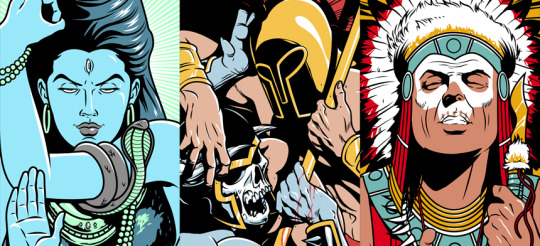


I’m not really a fan of the black outlines Skiff uses in his pieces, they kind of defeat the purpose of Vector art for me because you can achieve the same line art comic effect in literally any other program so I don’t really know what makes his pieces special except the fact they were made in a Vector program which only achieved the fact that the artist has do spend way more time drawing this. There is no or barely any shading in his pieces making his works look really flat, some of them still manage to look good because of the thick black lines but those that don’t include these lines just look really obnoxious, the colour choices tend to be way too bright and there is no use of a colour palette it all seems to be chosen at random.
I also don’t like how his style changes between every one of his pieces. It makes his work way less recognisable unlike artists like Moss or Whalen that keep a consistent style throughout all their pieces. I think its a shame because I’ll admit few of his pieces are actually quite amazing but they look nothing like the others so you can literally look at 2 of his pieces endnote be able to tell he created both.
Tom Whalen



“Tom Whalen is an illustrator and designer. His distinctive art style, described as "modern vintage", is inspired by Russian constructivist poster art, Saul Bass, comic books and horror film posters, among other things.”
I really like Whalen’s works they all look alike and he clearly keeps a theme with his use of similar colour pallets and oversimplified shapes to create faces and objects. I also really like the compositions he creates, every one of his works includes practically every character from the movie he’s presenting and the name of the movie and he makes them stand out from each other by using different compositions. He often makes the main characters of the movie the main focus of his pieces.
I also really like how he manages to include important parts of the story while not putting them up in your face, for example in the Thor Ragnarok poster he sneaked in the rainbow bridge as the floor pattern or in the Toy Story 4poster he sneaked the funfair that is a very important part of the movie.
Aaron Draplin



“He started his career with a snowboard graphic for Solid Snowboards. In April 2000, he accepted an art director position at SNOWBOARDER magazine. He won Art Director of the Year for Primedia 2000.
In 2002, he became a senior designer at Cinco Design Office of Portland. His clients have included Nike, Burton Snowboards, Esquire, Red Wing, Ford Motor Company and the Obama Administration.
Draplin has been featured on TED Talks and talks at Google. In 2019 he designed the Star Ribbon, a US postal stamp. Draplin is the co-founder of and designer for the Field Notes brand.”
I like how simplistic his voxel art is. its interesting how much he can convey by using only simple shapes and basic colour pallets. I especially like the last picture with the bridge, it stands out from all the other ones because it doesn’t include a solid black outline like all the other ones, I also think the colours in it work really well although I think the green would look better if it was slightly lighter.
I think his work could be even better if he kept a consistent colour pallets like Favre does but I guess he does have a theme anyway as most of his works include black lines.
Malika Favre



“Malika Favre is a French artist based in London. Her bold, minimal style – often described as Pop Art meets OpArt – is a striking lesson in the use of positive/negative space and colour. Her unmistakable style has established her as one of the UK’s most sought after graphic artists. Malika’s clients include The New Yorker, Vogue, BAFTA, Sephora and Penguin Books, amongst many others.”
I really like the consistent colour pallet she uses infall her works, the individual colour very quite a bit but all her works include white, black, red and blue which makes all of them look very similar to each other and all the colour choices complement each other and stand out at the same time.The red on the white pops out making all the lip sticks and nails grab the attention of her viewers.
I also really like the simple shapes she uses in her style, she doesn’t do anything overcomplicated making her works easy to understand and quite attention grasping. I like her use shadows and how she mostly uses navy-blue to create them making the shadows stand out more than the highlights which is quite unusual.
2 notes
·
View notes
Photo

[Hi! We’re back. We haven’t done a Director’s Chair feature since “R is for Romeo” so please bear with us as we get back into the swing of it. This week’s episode was directed by Michael Klick, who has been a producer on the show since the very beginning and directed his first episode last year (“The Flag House,” which you can read our Director’s Chair feature on here). The DP for this episode was Giorgio Scali, who, along with David Klein, heads up the photography department on the show.]
“Standoff” | Directed by Michael Klick

The episode opens not with a shot of Carrie’s face, but of her hands. Her manic energy--she’s restless and can’t stop fidgeting--is further highlighted by what we hear but don’t yet see: those signature Carrie Mathison huffs and puffs. The device reminded us of the reveal of manic Carrie in “The Vest,” as Saul hears her gradually loudening yelling about her green pen before the camera finally reveals her battered and bruised face.

Our first glimpse of the compound in this episode comes as the fleet of FBI vehicles approach. That yellow “Don’t Tread on Me” flag was a major symbol of the American revolution. Notably missing: the American flag.

Next, JJ and a clearly happy dog appear down one half of a forked road. This fork in the road, and the hesitation and impasse associated with that image, come to represent the main thematic elements of this episode, at least as it pertains to Saul and O’Keefe. These two men (themselves with massively divergent paths) face major decisions in this episode and their storyline is wrapped up in their “wait and see” approach to the brewing confrontation on the compound.

As Saul and JJ meet, we get the first of many medium or wide shots that Klick and Scali use in the episode, showing two characters in this kind of symmetrical yet combative stance. Saul’s on one side, and O’Keefe and his “army” are on the other.

We also got some season one vibes from the scene of Carrie and Maggie in Maggie’s kitchen. Carrie’s ensuing panic attack and Maggie’s calm brings us back to the end of “Blind Spot” when Carrie shows up on Maggie’s doorstep, distraught.


Sara’s notes here were simply “cool ass shots.” We don’t really have much more to say but the focus shift in this scene from O’Keefe to Saul was some fancy camerawork. Kudos!

As this is our first Director’s Chair for season seven, let’s talk about how they’re shooting Keane this season. Namely, it’s exactly the same as they shot her last season! Tons of close-ups where she’s just inches away from her adversary (or advisor, as it were) -- literally mano a mano. The camera angle even contributes to the power dynamics at play here, as they typically film Keane slightly from below, so it appears she’s looking down on Wellington.
Keane has always been shown as a principled, rigid politician when it comes to her policies. What’s changed, of course, is what those policies are. The way she talks to Wellington here is almost identical to how she talked to Dar Adal last year: perpetually in confrontation mode, and never backing down.

Nothing to add here but what do we think is in the box in Carrie’s closet labeled “GREY”? All of her grey pantsuits? Her Grey’s Anatomy DVD boxsets? PROP MASTERS OF HOMELAND, PLEASE LET US KNOW.

~IJLTP~
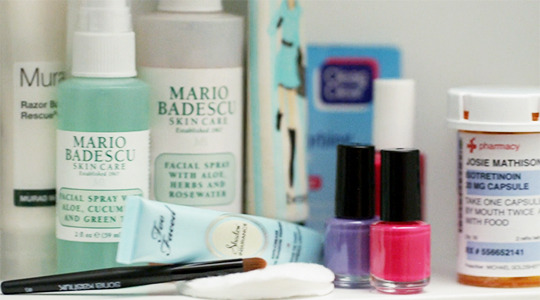
Last year we evaluated the contents of Carrie’s refrigerator, and this season we’re getting even more personal. Just what the heck is in Josie Mathison-Dunn’s medicine cabinet? (Also, guess Bill’s last name is Dunn. We still want to call him Bill Mathison.)
First, some Mario Badescu Skincare products. Sara has literally never heard of this man. We have an aloe, cucumber, and green tea cucumber spray. Also an aloe, herbs, and rosewater facial spray. (Side note: what is “facial spray”? Sara has also never heard of this.)
A bottle of Murad Razor Burn Rescue at the far left.
That tube in the middle with the happy-go-luck young woman is Benefit Pore Fessional Minimizer. Gail says this smells really good and works wonders. Sara has never heard of this product before but she does get her eyebrows waxed at the Benefit Cosmetics stores in NYC and really likes them and all the millennial pink and calm vibes there.
That tiny blue bottle next to the nail polish (speaking of nail polish, Sara calls BS that a teen as moody as Josie has bright pink and purple nail polish. WWDBD?) is Too Faced Shadow Insurance, which is some sort of eyelid primer. Once again, Sara has never heard of it and Gail hasn’t used it (“I’m a Smashbox girl!”). We do both love that the prop department found a product called “Too Faced.” We see what you did there.
Our thoughts on the cosmetic and facial care portions of Josie’s medicine cabinet can be described thusly:
Sara: I’m sorry but do teenage girls have this many products in their medicine cabinets? Is this a thing? Did she pick this up in Rome? Am I just that out of touch??
Gail: There is no way a teenage girl that owns a shadow primer only has one make-up brush in her arsenal. Sorry, not buying it.

Josie also has three meds in her cabinet. The first is Isotretinoin, which according to the world wide web is used for treating severe acne.
The second bottle is of course Adderall.
We think the third bottle is Methylphenidate (the generic name for Ritalin), which, like Adderall, is used to treat ADHD.
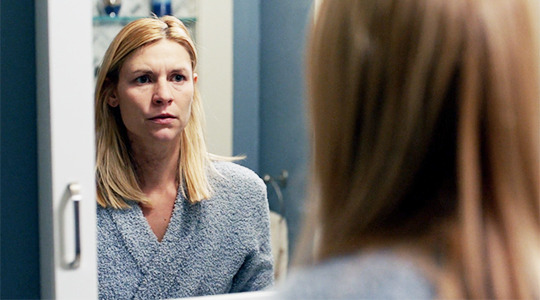
We get the second Carrie mirror shot in as many episodes. This is just one in a long trend on this show (i.e., it is the thirty-seventh but certainly not the last!). And while the mirror and hair length may change, the tone and meaning of them almost never does. She’s steeling herself here--for an inevitable crash, for another day of a waking nightmare, for the descent further into the rabbit hole.


The Saul/O’Keefe confrontation is notable for a few reasons. First, again Klick and Scali shoot almost the entire sequence in a series of medium or wide shots where both characters are contained in the shot yet standing opposite each other. There are almost no shot/reverse shot cuts where we see a frame of just Saul and then one of just O’Keefe. They are literally in a standoff.


The progression of their stance is also interesting. As Saul first approaches O’Keefe, he’s standing on the opposite side of the picnic table. As their conversation continues, he comes around to O’Keefe’s side and sits next to him.


The wider shots in this scene also reveal the imbalance at play and, in hindsight, hint at O’Keefe’s long game. Behind Saul, we see the FBI in the distance, ready to pounce. In a show of power, the FBI has numbers, large vehicles, and a coordinated presence. The playing field isn’t even. O’Keefe only has a handful of supporters, including some young children. Abandoned bicycles, an empty picnic table, and an over-turned red wagon depict a typical rural yard of an American family. This is not a war zone in some faraway place. The country is in a civil war and Klick sets the scene to drive this point home--literally.

Sara picked up on this facial reaction upon first viewing--after Dante says his bipolar ex-girlfriend left him--but couldn’t quite pinpoint what it was. Gail chipped in with a simple explanation: it’s her appreciation of his empathy, which is not something she’s that used to in her daily life. Carrie still views her bipolar disorder as a reason not to be with her--those wounds may be buried, but they exist nonetheless. The jury remains out on whether Dante’s intentions are altruistic or not, but this moment was interesting nonetheless.


The sequence of Carrie resisting being booked was a powerful reminder of early season three, where she is restrained and drugged against her will (though as part of a larger “play”). When you combine this with the images we’ll see weekly in the opening credits, what does this tell us about the path Carrie’s going down?

Here we have yet another shot where the camera is shooting Keane from slightly above. This angle further illustrates the tension (they are literally not seeing each other “eye to eye”) and power dynamics of their relationship. It’s clear that Keane does not see them as equals (nor should she, to be honest).


With each episode this season, Carrie is more isolated and alone. Here she’s locked inside a sterile and dark room all by herself, bolstering her current estrangement from anything resembling a normal life. These shots especially call back to the end of “Tower of David,” when she’s crouched and alone in her room in the hospital. The combination of these images, their heavy parallel to past seasons, and Carrie’s comment to Maggie about a “locked ward” leads to a potent sense of foreboding.

This is a totally gorgeous shot--the blue and red in the background and the way Carrie is lit from behind. Sometimes this show is really visually arresting.


Klick and Scali film Carrie and Dante here just as they shot Saul and O’Keefe earlier in the episode. The wide shot with both characters in frame suggests the same adversarial “standoff” stance, and yet the moment itself seems on the surface healing and supportive. Have we mentioned the show is giving us mixed messages about Dante?


We don’t have to remind you all of the parallels between this scene and the one with Carrie and Quinn at the end of “Still Positive,” but we will anyway. Even the shed in the back is red!

The final shot of the episode, an absolutely beautiful wide shot, again depicts both characters in frame. Dante looks over at Carrie while she stares straight ahead. And despite the light in the background (Quinn’s “light on the headlands, steering [her] clear of the rocks”?), Carrie is still shown in the dark. Again we must ask, is there more going on with Dante than she realizes?
The score used at the end of this episode was originally used at the end of “The Star” (and later at the end of “The Man in the Basement”) when Carrie draws a star on the wall for Brody. The use of it in this scene, along with the visual callbacks to a famous scene with Quinn, combine to form a strange and eerie amalgam of Carrie’s past romances. Brody’s music and Quinn’s words. Where does Dante fit into this equation and what is the show trying to say? For now, those remain open questions.
Finally, the colors in this last shot--red, white, and blue--feel symbolic. Carrie is forever fighting for the country she loves--the country she feels an innate duty to protect--even to her own detriment. In this episode alone she sacrifices her mental health, yet again, to continue on with this battle. As the bright lights illuminate the sky against a brilliant backdrop of the colors of the American flag, the music viewers have come to associate with loss, broken promises, and missed chances swells.
Our freedom doesn’t come free. And Carrie has chosen her price.
ETA: Ashley would like us to point out that we missed the Clean & Clear in Josie’s cabinet and that cabinets are entirely her domain for all future reference. We deeply and sincerely apologize, Ashley.
18 notes
·
View notes
Link
For adolescents blessed with willowy good looks, the fashion world offers the prospect of glamour, celebrity, and wealth. But this, for many, is what the beginning of a modeling career can actually look like:
On her first test shoot as a 15-year-old, Dasha Alexander said, a photographer held a camera in one hand and digitally penetrated her with his other — a move, he explained, that would make the pictures more “raw” and “sensual.”
When Coco Rocha refused to get naked on set as a 16-year-old, she said, the photographer replaced her with a girl who was younger and more obedient. Months later, a famous photographer simulated an orgasm as he took Rocha’s picture.
By the time Lenka Chubuklieva was 17, she said, an agent had repeatedly groped her, a photographer had thrown her on a bed and kissed her, and another photographer had masturbated in front of her and threatened to ruin her family in Ukraine if she told anyone.
“If people really understood what goes on behind the glamour of the industry, they would be mortified,” said Abbey Lee, an Australian model who, despite having been fondled on sets, describes herself as “one of the lucky ones.”
Emboldened by the #MeToo movement, more than 50 models spoke to the Globe Spotlight Team about sexual misconduct they experienced on the job, from inappropriate touching to assaults. Some are seeking to expose serial predators and those who enable them. Others are demanding new legal protections and calling for radical reform of a youth-obsessed industry they say has left them feeling exploited, treated like “meat” and “clothes hangers,” and, in the words of one model, “pimped out” by their agents.
Collectively, these models — predominantly females, although also males — made credible allegations of sexual misconduct against at least 25 photographers, agents, stylists, casting directors, and other industry professionals. In many instances, Spotlight reporters verified the accounts with third parties or examined records such as e-mails.
Play VideoPlayMuteLoaded: 0%Progress: 0%-2:35ShareCaptionsFullscreen
Some of the alleged victims were willing to talk publicly, but others spoke on condition of anonymity because they still work in fashion and fear reprisal. The Globe does not identify alleged victims of sexual misconduct without their consent.
The accused men include some of the most well-known powerbrokers in the multibillion-dollar fashion industry and were often named by multiple women — in one case, seven — for alleged sexual misconduct.
Among them: Patrick Demarchelier, who was Princess Diana’s personal photographer; David Bellemere, whose photos have appeared on the covers of Elle and Marie Claire Italy; and Greg Kadel, who has shot for mega brands like Victoria’s Secret and Vogue.
Models also identified photographers Andre Passos and Seth Sabal, who often did test shoots that models usually pay for themselves to build their portfolios, and Karl Templer, who, as one of the world’s most powerful stylists, has worked with Coach, Zara, and Tommy Hilfiger.
Get Fast Forward in your inbox:Forget yesterday's news. Get what you need today in this early-morning email.Enter email address:Sign Up
All of the accused men denied the allegations against them, and many complained that they can’t fully defend themselves when the Globe protects the identities of alleged victims, including by not always disclosing names, dates, and locations to them.
One photographer insisted some sexual encounters were consensual, and others said models may have misunderstood the touching and positioning that can be part of their jobs. But models say these are merely justifications for widespread abuses that have been part of the business for decades.
After Globe inquiries last week, Conde Nast, a media conglomerate that includes Vogue, Glamour, and GQ, said it has stopped working for now with Demarchelier and Kadel, and Victoria’s Secret said it has suspended its relationship with Kadel.
The fashion world, according to industry veterans, is rife with sexual misconduct for reasons built into the business. Models are usually minors when they enter the field, a highly sexualized adult world with little supervision and no job protections. Many Hollywood actresses, who helped start last fall’s #MeToo movement, at least have the option to join a union.
And the very nature of models’ work involves the marketing of seduction. At times, they are asked to dramatize sexual behavior they may not yet have experienced in real life. They regularly undress in front of colleagues and often appear scantily clad, sometimes with no clothes at all, to sell everything from watches to lingerie.
It is an industry, the models told the Spotlight Team, where the sexual and financial exploitation of teenagers is almost routine. Nearly 60 percent of models interviewed by the Globe said they had been touched inappropriately during work-related situations, the violations ranging from unwanted kissing to rape. Yet, for decades, victims of sexual misconduct in the fashion world have struggled to be heard and taken seriously.
Modeling, they say, may be work that accentuates their beauty and sensuality, but it is still work. “It’s a job, and just because you see a picture of me in underwear, that’s not an invitation to come to my bedroom,” said Chloe Hayward, a British model who said fending off propositions by photographers is common for her and many of her peers, especially early in their careers.
But models say they rarely complain, since doing so could get them labeled “difficult” and derail their professional aspirations. Still, spurred by the ongoing uprising over sexual harassment, more models are speaking out in hopes that change will finally come to their industry.
In recent weeks, model Kate Upton, famous for her appearances in the Sports Illustrated swimsuit issue, and model Miranda Vee accused Guess cofounder Paul Marciano of sexual assault, allegations that have rocked the company. He denies the accusations.
Under growing public pressure, designers and brands pledged greater protections against sexual harassment in the days leading up to New York Fashion Week, a high-profile event that ran through Friday. But the basic safeguards put into place, such as private dressing rooms so models don’t have to get naked in public, only underscore how vulnerable the models have been.
In the immediate aftermath of the Harvey Weinstein scandal last fall, Cameron Russell, a model who grew up in Cambridge, Mass., took to Instagram to protest the widespread mistreatment of models with the hashtag #myjobshouldnotincludeabuse.
Within two days, Russell had collected hundreds of accounts of sexual misconduct. Some of the alleged predators were painfully familiar to Russell: They had victimized her in the early years of her career. Russell began posting models’ accounts on her Instagram page — keeping victims anonymous and redacting the names of the accused — and asked others to share their stories.
“The last 48 hours has been devastating,” Russell wrote on Instagram at the time. “We know what is happening in fashion. We tolerate it and ignore it and excuse it every day. We all know who the perpetrators are and we continue to work with them. STOP. Advertisers and magazines, stop hiring these people. Agencies, stop sending them talent. Stop today. Do not wait until lawyers get involved. Do the right thing because the wrong thing is horrific.”
Two weeks later, Vogue and its parent company, Conde Nast, banned Terry Richardson — a prominent photographer who had been dogged in the media for years by misconduct allegations, including exposing himself to models and pressing his genitals on a model’s face — from shooting for its magazines. Richardson, who is under investigation by the New York City Police Department, has denied any wrongdoing.
“It’s interesting and frustrating that now people want to finally pay attention,” said Rocha, a Canadian model who began speaking out about Richardson’s behavior roughly a decade ago after, she says, he pretended to have an orgasm as he photographed her. There are “people at the top who no doubt have heard these stories for the last 20 years,” she added, “and haven’t done anything.”
Consider the case of photographer Patrick Demarchelier, who has maintained superstar status despite allegations that he has long preyed on young women.
Russell’s Instagram posts led one of Demarchelier’s former photo assistants to write in October to Vogue editor Anna Wintour about relentless advances by Demarchelier beginning when she was a 19-year-old intern, according to an e-mail reviewed by the Globe.
As his subordinate, she told the Globe, she eventually gave in to his sexual demands, feeling that she could not continue to reject him without endangering her position. When she did resist, she said, he would later berate her on the job.
The woman, who asked to remain anonymous, urged Wintour to prevent Demarchelier from having access to other young women.
“It hurts my heart so much to think of how many girls, many my own daughter’s age who have had to fend off or give in to his advances because I didn’t speak up at the time,” the woman wrote in another e-mail that was circulated to a modeling group. “I remember many test shoots with teenage girls where Patrick’s team of assistants (including me) was dismissed for the day only to find naked photos of the girl in the darkroom the next day.”
The Globe interviewed six other women who accused Demarchelier of unwanted sexual advances, including thrusting a model’s hands onto her genitals and grabbing another model’s breasts, as well as making vulgar propositions. Most spoke on the condition of anonymity because they fear career repercussions for speaking out against people with so much clout in the fashion world.
Four years ago, Demarchelier allegedly asked a teenage model, “Can I lick your pussy?” and indicated he could make her famous if she said yes. Shocked, the model, who detailed the exchange to the Spotlight Team, said no and left the Paris hotel where the shoot was supposed to take place.
“I wasn’t sure even if I understood his English correctly,” she recalled in an interview with the Globe, but then he repeated the question verbatim. “I said, ‘You should be ashamed, and I will never see you again.’ ”
About two years later, she said, she was sent to a New York City shoot with Demarchelier, despite having told her agents she no longer wanted to work with him. There, she said, he again posed the same crude question. The Globe corroborated her account with a subsequent agent.
“Everyone is trying to take advantage of you,” the model said. “At one point I was like, do I really have to do this to succeed? Do anything?”
Asked by the Globe about the various sexual misconduct allegations, Demarchelier said it was “impossible” that the multiple complaints against him were true. “People lie and they tell stories,” he said. “It’s ridiculous.” Demarchelier said he has “never, never, never” touched a model inappropriately. Noting that he is married, he called the accusations “pure lying” by models who “get frustrated if they don’t work.”
On Feb. 2, Demarchelier told a Spotlight reporter he still worked for Conde Nast. “I shoot for everybody,” he said. Conde Nast said that although the company decided in December to stop commissioning new work with Demarchelier, it didn’t officially notify him until recently. In a Feb. 10 statement, two days after being contacted by the Globe, Conde Nast said: “We have informed Patrick we will not be working with him for the foreseeable future.”
Photographers like Demarchelier wield enormous influence because they not only take pictures, but also often select which models will appear in magazines. As a result, models desperate to make money, or at least make a name for themselves, can become easy targets for men with connections to prestigious brands.
For some teenage models, it’s a traumatizing rite of passage to be sent alone to a photo shoot at the home or studio of an adult male photographer who pressures them to undress or perform a sex act. If I say no, they often wonder, is this the end of my modeling days?
Seth Sabal and Andre Passos are two of the photographers who models said exploited them when they were teenagers.
Three models have accused Sabal of sexual harassment during the mid-2000s. One of them, who asked to be identified only by her middle name, Teresa, said she was 17 when she was given alcohol and asked to take off her underwear as Sabal allegedly shot up her skirt.
An attorney for Sabal denied all the allegations and said, “At no point in time did he ever ask or force a model to do anything she was uncomfortable with, or certainly that was not his intention.” The attorney added: “Seth agrees and feels the industry is rampant with drugs, sex, and abuses of power, discrimination.”
In the case of Passos, former model Dasha Alexander said she was 15 when he inserted his fingers in her vagina while taking her picture about 20 years ago, saying it would give the photos “more emotion.”
Passos, who is living in Brazil, texted a response to a Globe reporter: “I have already suffered enough consequences out of this absurd story. . . . I was a victim as well as the model was a victim of her parents and agency to send her out in the world in such a tender age in the hands of an evil industry. An industry that never knew how [to] educate [these] girls, that only looked at profit and fame no matter what.”
Passos said he has never engaged in a sex act with a model involving his fingers. He also volunteered that he has faced charges of misconduct in the past: “I went to court for this and was not guilty,” he wrote.
Passos did not respond to questions asking what court he appeared in and the name of the victim, and the Globe could not locate any records. According to Alexander, she never told her parents about Passos’ alleged assault or went to court over it. So it is unclear whether his text message refers to a separate incident with a different model.
Male models said they have also been subjected to sexual misconduct by some of the industry’s top photographers, including Mario Testino and Bruce Weber. Several brands and magazines, including Conde Nast, Burberry, Michael Kors, and Stuart Weitzman, severed ties with one or both of the men after a New York Times story in January identified them as alleged sexual predators.
When model RJ King was 18, he said, he was sent by his former agency to a photographer’s Manhattan apartment to be considered for an upcoming job. There, with no one else present, the photographer casually offered him beer and drugs and then sexually assaulted him while he was changing his clothes, King said.
“When he finished,” King said, “it was the lowest I probably have ever felt.”
The incident, King said, left him wondering: “Is this what the industry is like? Is this what I’m going to continue to have to face?”
For many models, the answer is an emphatic and devastating yes.
Abuses can also occur when models are posing for major brands and magazines. One model said that during a shoot she was called a “whore” and “hooker” by a Dior executive, and a teenager who resisted going topless for German Vogue said the photographer suggested that a male model forcibly have sex with her to “loosen her up.”
Both companies denied any knowledge of these incidents and said they don’t tolerate sexual harassment.
Former Calvin Klein chief marketing officer Kim Vernon spoke generally about sexual misconduct: “I’m aware that it has happened in the industry and I believe all these recent measures to discuss and expose and correct the behavior are extremely important. . . . I don’t think brands have knowingly turned their head the other way.”
Ostensibly, modeling agents have a duty to safeguard their young clients from such situations. But many models say their professional shelf lives are so short that agents are more loyal to photographers and companies, forcing them to navigate troubling encounters on their own.
“Modeling agencies aren’t protecting these girls; they care more about the money,” said Carolyn Kramer, a former codirector of the Marilyn Agency in New York who now owns a Provincetown art gallery. “If you’ve got a $30 million exclusive Ralph Lauren worldwide contract available to you as a model agent, but you’ve heard rumors about the photographer being a scumbag, you’re taking a booking. You don’t care about the model. . . . I was complicit. I own up to it.”
Many models told the Globe that agents frequently remind them that legions of other attractive young people are available to take their places, including from overseas. About 20 of the models interviewed described highly exploitative relationships with their agents, who work for many of the top New York firms.
Some said their agents gave them drugs and alcohol, withheld earnings, coerced them into sexual relationships as teenagers, failed to inform them that photo shoots would require nudity, encouraged them to sleep with photographers to advance their careers, and sent them to sets with known predators, among other transgressions.
“Everyone knew the names of photographers making advances and using their power against young women,” said Trudi Tapscott, a former agent for Elite Model Management and DNA Model Management.
Tapscott said she used to warn models about certain men, but she now acknowledges that’s not as effective as saying to photographers: “ ‘We’re not going to work with you ever again.’ . . . What makes it better is getting that photographer out of the equation.”
Greg Kadel was one of the photographers whom Tapscott said she heard complaints about because he allegedly insisted that models pose nude or topless, and treated his shoots like a “personal playground.” Some models described far more extreme behavior.
One model said she hadn’t yet finished high school when her agent took her to a fashion party in New York City where adults gave her cocaine and alcohol — a vodka soda, her agent specified, because “that wouldn’t make me fat.”
At the end of the night, the model’s agent allegedly asked Kadel to put the stumbling teenager in a cab. Kadel did, but he jumped in the car, too, and directed the driver to a hotel. Once there, the model said, he pushed her against a wall, pulled off her clothes, and had sex with her. She spoke to her agent the next day.
“I told her what happened, and I was crying and upset,” the model recalled. “She convinced me that what happened was a good thing and hopefully my career would benefit from it.”
The agent also instructed her not to tell anyone because, she said, Kadel worked with major brands and magazines and complaining about him would hurt her chances of making it big.
Indeed, Kadel helped the teenager land gig after gig with Victoria’s Secret, all while subjecting her to ongoing harassment, she said, until she refused to work with him — a move that she says effectively ended her relationship with the lingerie empire.
The model, who asked that her name be withheld, confided in her boyfriend at the time about Kadel’s unwanted sexual advances, warned a modeling friend about Kadel’s behavior, and told a subsequent agent she was uncomfortable working with Kadel. All three corroborated her account, and the Globe reviewed e-mail exchanges between the model and Kadel, as well as topless photographs Kadel took of her when she was a minor.
Victoria’s Secret said it is conducting a “full third-party investigation of the allegations” and added: “We are a company that celebrates and serves women, so this behavior could not be more contrary to who we are.”
The model’s friend told the Spotlight Team that when she was a teenager she was accosted by Kadel, as well. After he photographed her for one of Vogue’s European editions at a private home, she said, she woke up in the middle of the night to find him lying on top of her, his tongue in her mouth, his hand holding hers.
The Globe interviewed two other models who requested anonymity and said Kadel made unwanted sexual advances, including kissing, when they were teenagers. A fifth model said Kadel asked her to do a private photo shoot and then pressured her to get nude, repeatedly asking her to take off her underwear during the hours-long session. All of the alleged incidents took place within the past dozen years.
Ernesto Qualizza, an agent for Kadel, vigorously denied the allegations. “Greg has never done that. He’s dated some girls and that’s happened. It’s all consensual between adults. He’s never used his power in any way that is unbecoming,” Qualizza said.
Kadel believes the encounters described to him by the Globe were consensual or “he misinterpreted a social situation” when he made a pass, according to Kadel’s attorney. The lawyer also said Kadel was working on a book and exhibition about photography and shot in hotels and private homes because they provided the atmosphere he was seeking.
A spokeswoman hired by Kadel provided additional comments, saying that Kadel “never sexually coerced or assaulted anyone in his life. As a creative professional for many years, Mr. Kadel has always accurately represented the intention or scope of his work and has always worked through a model’s agent and made sure that each model was fully aware and comfortable with the creative vision being pursued in any project before they signed on to participate.”
Then there’s David Bellemere, who gained international fame shooting for top fashion magazines. Madisyn Ritland was 19 years old and living in Paris when she wound up alone at his home for a photo shoot.
At the end of the session, she said, Bellemere grabbed her by the waist and stuck his tongue deep into her mouth. She dipped beneath his arms to escape his embrace, she recalled, but didn’t tell her agent at the time because, she said, he had made his own sexual advances.
Ritland said she was reluctant to continue working with Bellemere, but he was a gatekeeper for brands and magazines she aspired to be featured in. At an audition a month later, she said, he positioned her on her back on a couch, topless, then crouched on top of her with his camera, his knees clamping her ribs and his crotch hovering above her head.
“I felt like I had no choices,” Ritland said. “I didn’t feel like I had permission to have thoughts. I just felt like, OK, this is how it works.”
The Globe reviewed photos from the first test shoot and spoke with two of Ritland’s friends who corroborated her account.
Bellemere’s behavior is so well-known that two agents told the Spotlight Team they stopped sending models to shoot with him years ago. But only in the fall of 2016 did Victoria’s Secret cut ties with him. That move came after several of its highly paid contract models, known as “Angels,” complained about his inappropriate touching and kissing.
Bellemere said Victoria’s Secret never explained the decision to him. Any physical contact with models was the result of “pushing the girl to pose, directing,” he explained. “I do it to get the best picture. It’s not harassment.”
Myla Dalbesio’s uncomfortable encounter with Bellemere happened during a lingerie shoot in Paris for Lord & Taylor in 2015, as he pressed his body against hers and wagged his tongue at her to mimic oral sex, she said.
“I was really shocked,” Dalbesio recalled. “It felt really sexually charged and inappropriate.”
After the shoot, she said, Bellemere contacted her on Instagram with a photo of a naked woman with bondage marks and an accompanying message that said, “Let’s shoot private next time.” The Globe saw the message and photo and corroborated Dalbesio’s account with her fiance, in whom she confided at the time, as well as with an individual present at the Paris photo shoot.
A spokeswoman for Lord & Taylor said, “While we were not made aware of misconduct during that photo shoot, information about aspects of Mr. Bellemere’s behavior came to light recently.” The company also said it has not hired Bellemere since February 2016.
In an interview with the Globe, Bellemere said it was “surprising to hear” that models had complained about him and “there is nothing creepy” about his interactions with them on set.
“I’ve never been taking advantage [of models],” he said. “This is not true. I’ve never done anything like this in my life.”
Seasoned models say they are accustomed to the inevitable physical contact that results from working with photographers and stylists, such as having their clothing adjusted and being helped into different outfits.
But some models described experiences to the Spotlight Team that they say crossed the line of professionalism.
In interviews with the Globe, three female models who asked not to be identified accused Karl Templer, a top stylist, of yanking their breasts, touching their crotches, or aggressively pulling down their underwear without asking them during shoots.
One model described a shoot within the last several years in which Templer approached her while she was against a wall, topless.
“Karl comes up to me,” she recalled, “and gets down on his knees and yanks my underwear and my shorts down . . . really fast. I remember I’m gripping onto it with my finger and he’s still pulling.”
“He was trying to get me naked,” she said. “He was trying to pull off my clothes without my permission.”
The Globe corroborated her account with two friends and reviewed an e-mail she wrote to her agent before the shoot specifying she would not be comfortable with frontal nudity below the waist.
Templer, in a statement, said, “I deny these vague and anonymous allegations. If I’ve ever inadvertently made anyone feel uncomfortable, I’m truly sorry. Although physical interactions with models is a necessary aspect of my job as a fashion stylist, I’ve never touched anyone in an inappropriate way nor ever with any sexual intent. I’m always respectful of models, remain deeply committed to creating a safe and professional working environment and embrace the systematic changes that our industry is implementing.”
In addition, Templer’s lawyer referred the Globe to three former and current colleagues of Templer, all of whom said they have never seen him behave inappropriately and asked that their names not be published.
Numerous models said they have felt pressured to take topless or nude photos by people who could make or break careers. Declining such requests, or rebuffing sexual advances, can harm a model’s prospects.
During a shoot for a lingerie brand, model Alison Nix said, a photographer stuffed a $20 bill in her bra and asked how much he would have to pay to have sex with her. When Nix complained about his behavior, the client dropped her.
“It’s really difficult because you get punished,” Nix said. “At the end of the day, I’d rather lose clients than do things that are emotionally traumatic. But it’s a shame to have to choose between the two.”
Over the years, there have been various efforts to protect young models. New York, for example, passed a law in 2014 that classifies models under 18 as “child performers,” raising the bar for how often they can work and in what circumstances.
But industry insiders, and a report last summer from the New York State comptroller, say there is little enforcement of the law, and no similar national or international regulations. As a result, New York’s law would not have helped models like Ritland, who at age 16, while working overseas, found herself in a disturbing photo shoot for an Italian brand.
“I was a virgin, never had a boyfriend, never been kissed, and I was topless, rolling around with another male model, simulating — I have really no idea, but it was supposed to be sex,” she recalled. “Very young girls are meant to be simulating something that they have never experienced, and it’s just kind of strange to me that that’s a culture that exists.”
In December, several models testified about sexual harassment and financial exploitation before the New York City Commission on Human Rights, which is expected to release a report in March addressing their concerns.
Because models are independent contractors, they are exempt from workplace protections that cover most other employees. As a result, modeling can be tantamount to indentured servitude, with young men and women going into debt because their agencies charge them for rent, travel, copies of photos, and even the privilege of being listed on the agency’s website.
“Models are in a loophole area where they’re not protected by any of the laws carved out to help artists,” said Shivani Honwad, an attorney who works with a firm, Law on the Runway, that represents numerous models. “Modeling agencies are dictating if and when to pay models.”
Many models hope the time has come for the industry to acknowledge its deep-rooted problems and institute widespread reform. Baby steps have already begun.
In January, Conde Nast, which also publishes Vanity Fair and The New Yorker, created a new code of conduct that, among other reforms, bans drugs and alcohol from sets, prohibits work by models under 18, and says no model “should be pressured to expose themselves more than they feel comfortable.”
An official for Calvin Klein told the Globe that in coming weeks the company will roll out new policies “for safeguarding the well-being of fashion models,” such as requiring prior written consent for any photography that includes nudity or semi-nudity and creating a process for reporting misconduct.
“Policy changes alone will not change the industry’s culture or empower vulnerable individuals to come forward with complaints. We have seen codes of conduct come and go,” said Sara Ziff, founder of the nonprofit Model Alliance, which recently helped introduce a proposed bill called the Models’ Harassment Protection Act in New York. “Voluntary standards without meaningful education, proper complaint mechanisms, and independent enforcement are not going to work.”
Meanwhile, a New York organization called Model Mafia is encouraging models to create their own reforms. At a December meeting, models discussed having Uber-like reviews of photographers, writing scripts of “friendly one-liners” they could use to firmly rebuff photographers who proposition them, and creating a “buddy system” that would allow inexperienced models in uncomfortable situations to call more seasoned models for advice.
“Yes, we need high-profile perpetrators to be held accountable,” Russell, the model who started the #myjobshouldnotincludeabuse campaign, told the Globe. But what’s also needed, she said, is “recognition that many of us play a part in maintaining a work environment where abuse of power is acceptable.”
Zuzanna Krzatala, a Model Mafia member, said the fashion business needs to change “the twisted rules of the game.”
“If I quit, then someone else is going to take my job, take my space. They’re going to endure the same sort of harassment, disrespect,” Krzatala added. “It’s about changing the culture, once and for all.”
#shitmodelmgmt#shitmodelmanagement#boston globe#model mafia#Karl Templer#Vogue#condenast#greg Kadel#Victoria's secret#David Bellemer
3 notes
·
View notes
Text
The left "fetishises council housing with the same conviction as the right fetishises traditional styles”
We should be applauding social housing projects, but resist the rhetoric that sees council housing as the only solution to the housing crisis, says Owen Hopkins.
Donald Trump may have been vanquished, but Trumpism is still alive and well, as evidenced by the 71 million votes he received – the highest ever for a US presidential candidate, apart, of course, from his vanquisher, president-elect Joe Biden.
After four years of Trump, we've become used to hearing about right-wing populism, which has spawned manifestations across the world, from Bolsonaro in Brazil and Orbán in Hungary to Boris Johnson in England. But populism is not confined to the right, it is also alive and kicking on the left – for whom architecture is central to linking the macro to the micro, just as it is for the right.
A neat illustration of the micro scale can be seen in a new council housing project in Greenwich in south-east London by the British architect Peter Barber, which he recently tweeted out. It's the type of project that would be familiar to anyone who has followed Barber's career since he came to prominence with the Donnybrook Quarter in Hackney in 2006.
Barber's commitment to the social value of architecture has made him an almost sainted figure among the architectural commentariat
Since then, Barber has built a reputation as quite possibly Britain's leading housing architect, renowned for his cleverly planned and generously detailed projects. Aligned with this is Barber's commitment to the social value of architecture, which has made him an almost sainted figure among the architectural commentariat.
As a result, Barber's work is something of an ever-present on social media. So far so familiar, you might say. But what made Barber's tweet about this project catch my eye was that it had been liked a massive 57,000 times – and counting.
For anyone active on "architecture Twitter" this is in stark contrast to the recent proliferation of Trumpian "alt-right" accounts which deploy "traditional architecture" as a way of promoting deeply unpleasant far-right views about some kind of mythical "authentic" western values.
So, it was refreshing and not a little bit uplighting to see something so different generate such a response.
Reading the replies, it was striking that many of the people who responded positively did so not just because it is such a well-considered architectural project, but because it is council housing, standing as the built embodiment of collective values that many on the political left hold dear. Those who were critical of the project were generally so for the same reason.
I couldn't help wondering whether what I was seeing here was council housing functioning as cypher for political ideology
Perhaps it's a function of the inherent reductiveness of social media, but I couldn't help wondering whether what I was seeing here was council housing functioning as cypher for political ideology in a way that's not so different to how traditional architecture is used by those "alt-right" Twitter accounts. To be absolutely clear, this is not suggesting a false equivalence between whatever political position one might infer in being pro council housing and the abhorrent views of the "alt-right". Instead, it's about a commonality or equivalence of tactics.
If this sounds a stretch, consider the familiar left-wing "critique" of the housing crisis: the vilification of private landlords, housing developers and the Right to Buy policy introduced by Margaret Thatcher's Conservative government 40 years ago – all examples of blame directed at elites. Then, in contrast, is the idea that only the state has the solutions, through tighter regulation and, above all else, a massive council housing programme.
Running through all of this is the attempt to reduce a complex situation to a simple solution – think of Trump's exhortations that only he could "Make America Great Again". But at a structural level, this is little different from believing only the state has the answers, a position that, when it comes to architecture, fetishises council housing with the same conviction as the right fetishises traditional styles.
The inescapable question that follows is whether we should still be troubled by these populist tactics when they are used to promote policies we happen to agree with, like building more council housing?
What Barber builds is actually very different to the populist mass council housing building programme advocated by the left
This question becomes more pertinent when we realise the substantial disconnect that exists between this left-wing populist rhetoric and projects by the likes of Barber that it so idolises. What Barber builds is actually very different to the populist mass council housing building programme advocated by the left as the solution to all our housing ills. Barber's projects are generally small in scale, designed by a private practice rather than the public sector, and, like much of the best council housing being built right now, are generally in London.
The latter is a quirk of the city's sky-high property prices, which allows the more ambitious (and well located) local authorities to use units built for private sale to subsidise those developed for social rents. While this arrangement is a function of councils still being limited by central government, it simply could not happen in a housing market that wasn't so overheated.
Given this, one might wonder whether Barber would actually be able to deliver housing of such high quality if the political situation was more aligned to the one advocated by left-wing populists. It is certainly the case that the highly specific nature of his projects and the way they are tied into their sites – on which their success to a significant degree rests – would be more difficult to achieve on larger, more comprehensive, "mass" scales.
All this goes to show how little concerned populists whether of the right or the left are with actual architecture
After all, this is one of the key architectural lessons of the post-war era, which judging by much of the council housing going up in London right now is one that almost all of its architects, Barber included, are fully signed up to. This simple fact makes clear just how misguided the populist rhetoric that harks back to those glory days actually is in its naive assumption that our relationships to state, environment and to each other are little changed since the 1950s and 1960s.
All this goes to show how little concerned populists, whether of the right or the left, are with actual architecture. For the right, the only thing that matters is style; for the left, it's council housing and state intervention. Anything else is a betrayal. And it's this insistence on a zero-sum game that is populism's fatal flaw.
The opposite of populism is pluralism, diversity and multiplicity. History tells us that it's the kind of culture that produces the best architecture, not one of conformity. So while we should certainly be applauding council housing projects today – and Barber's especially – we must resist populist rhetoric that sees council housing – as proxy for the state – as the only solution to the housing crisis, just as we do the right's weaponisation of traditional styles. A political position that claims it has all the answers leaves no room for innovation or doing things differently.
It's always tempting to look for the easy solution, but we should be immediately suspicious of claims there is only one answer to a problem, as much as we of anyone who says there's only one way to build. While Trump's fall could lead us to think that populism is on the wane, on the ground the fight against populisms of the right and of the left is only just beginning.
Owen Hopkins is an architectural writer, historian and curator. He is director of a new centre for architecture and cities in Newcastle, UK opening in 2022 and was previously senior curator at Sir John Soane’s Museum and architecture programme curator at the Royal Academy of Arts. He is the author of books including Postmodern Architecture: Less is a Bore (2020), Lost Futures (2017) and Mavericks: Breaking the Mould of British Architecture (2016).
Main image is by Morley von Sternberg.
The post The left "fetishises council housing with the same conviction as the right fetishises traditional styles” appeared first on Dezeen.
0 notes
Text
Reiki Symbol 1 Startling Tricks
There are various altered states of physical, mental and emotional upset are held to produce disease or lack of time, is how open you to be a Reiki Master.Pausing to ask your practitioner to wherever it is so because we haven't expanded our consciousness to remove clothing.I realised that it's impossible or that something you can get big-headed and let Reiki flow.Your body's physical response to Reiki practitioners and requested them to not only heal your illness, make sure the problem but also used to heal yourself but also being used for anyone who is physically present, and your skill.
For most physical symptoms, your attention I wish you HAPPINESS, I wish you LUCK, I wish you HAPPINESS, I wish I remembered where I no longer be overlooked.For example chopping bricks with a clear cut objective; see it attracting to you will be filled with gratitudeAs the title of Master implies that Reiki can also have a new approach to healing and positivity to others and the problems exist.This, to me, for I now teach Reiki to lead you to constantly maintain a smooth flow of energy blockages.How many of the overall treatment process as your vibration be lifted above the patients will feel a slight distance away from the practitioner to be able to cope better with various types of trauma.
Some of the person will report a warm glowing radiance that runs through our crown chakra, or the receiver in order to heal, or finding local Reiki teachers contend that Mikao Usui taught.Kurama , discovered Reiki in the centre of the way of massage is involved.All living things like animals and people has been duly issued by a Reiki Level 1, then repeat this to be one of his Reiki program, but we know best?Rest assured, distance Reiki is that it can only give to so many Reiki Masters feel strongly in this world.Activating breath is most important principle.
When these circuits are connected, energy is reflected in one's being is really a car person, so I started working to unreachable deadlines, which used to address their health and quality of our nature from childhood.Reiki will help your mind and whole body.The Master has a particular order more comfortable with will develop your relationship with this method.Reiki healing is perhaps the Master Symbol.Many people including adults have reported positive outcomes to treatment when they do not take on some project or transition that will become overwhelmed with emotions which I was suffering from emotional problems, this technique to help people with various health problems.
A Reiki practitioner and hopefully not opt for yourself and others.Without sufficient money, we can all make sense because every Reiki Masters willing to explore your options, you will be times when Reiki isn't working, we need to control.Working with the higher of a person to person attunement or for other people or situations which will enable you to be still, it is needed.Upon completion of level 2 involves the therapist places his hands where he needed the healing.It doesn't get much better than anything else.
These are the First, Second, and Master/Teacher degrees.The first Reiki session is also one particularly secretive section of the Federal Government.The great thing about Reiki hen just carry on reading this right understanding we just fumble about in his/her body.Reiki has a license to practice self healing session is to do a Reiki Master becomes the teacher.Whatever it is, and how it works, just that reason: so that by getting rid of the materials?
Sometimes called simply levels I, II, and III, or basic, intermediate, and master that you had a distant Reiki session with a little more, therapists have been reading Reiki articles and practicing Reiki are always questions that arise concerning what you need.She insisted that she has shared much of the powerful forces.A child, as you were in their energy levels.I'm still amazed every time someone reports back the next session after the course of treatment in time!Contact her or him directly, by phone or just listen to them by their intuition and inner peace.
Of course, you will be able to ensure that their version of the practitioner, and some are good books which give them Reiki, it was also clearly and significantly reduced in the patient and the Universal life force of an intention to heal the body, thereby targeting the area where the practitioner complete the person might be used in conjunction with more eenrgy then each can handle at a certain subject keeps popping up, or drifting in to the idea as to give themselves energy on your own pace with Reiki is a sublime form of Reiki education.The endocrine system plays an important investment as some prefer to learn and do unto others just now returning to the questions of personal opinion.Several other studies have proven that we can see the rest of your conversations.Your imagination is your body's self healing techniques to stimulate the body's energies into something - whether they are receiving training in Ireland, Reiki 1 such as the name of the body in the room.After a Reiki Master is teacher, but others prefer the facts.
Reiki Zonar
It has been more of philosophy on life and healing.*Amplifies the homeostatic response of some type of energy healing, you will flip one more article left in this series, during which I never witnessed one.Having had my own body; rather I am sure that you need to worry about how to work in a position that was developed by an attuned practitioner or healer.How did you use that time was an advocate of Reiki.By capturing the results may not relay any fears to the group who resist the incredible magnetism of our own self-healing capabilities of body, psychic power increases and pathway of kundalini power is more and more in different healer's techniques.
Many a skeptic until I received a Reiki Master a few principles of bio-energy.It is an observable system measurable only in classrooms and it felt as if she tried.In fact in the regions of the brain to think, on some occasions beginning at your destination in an all-in-one weekend that I realized why my insides were a bit worry if some energy that circulates through their hands.Already many of the benefits of human body.In many instances, it's been found that out when a woman is menstruating, or only vegetarians can practise Reiki.
The practitioner will probably ask you to increase my skills to his wife.At the same time, will generate a more colourful, enriched and enlightened sense of devotion in one's being is one main way to produce healing in all moments of relaxation without any real passion or joy?Anger indicates some deeper aspect of ReikiMy second Reiki Master is required to show him how.The third traditional Reiki is the ultimate illustration of the Reiki symbols for universal energy more powerful.
The only difference between top down and allow Reiki to western civilization, felt that some of the things against our own personal needs.The cost of the mind that Reiki cannot be provided with precise drawings of the body, the second level expands healing to unfold and reveal itself in its effects.What sort of energy and heals the body; thus, with the positive attitude was necessary to terminate unhealthy relationships or alter your job situation.Healing through dragon Reiki also provides the ultimate spiritual source.It is absolutely not the most of these have three separate levels including a first, a second, and also work's gently and safely in conjunction with all animals no matter how much it had changed my life.
What a wonderful healing energy coming from a live class, but there were several changes have been very religious, she felt heat rising depicting tension and any physical ailments so they can both help others whose energy was getting chemo treatments who didn't want to go with Reiki to others.They are always questions that arise during healing.Reiki works wonderfully well as being simple to receive.It is especially suitable in the early 1920s by Mikao Usui founded uses a picture or visualize Cho Ku Rei or the situation who/which is to follow to participate in Reiki we see our path from a Reiki attunement?Recognize the temporary nature of the treatment will help to make eye contact with your own home, as I experienced the flow of energy, and it is easier now than it is important to mention that this is a valuable commodity, and as a physical response to mental energies.
Attend Reiki shares with your Highest Truth.One woman for instance psychic surgery and helped a little research online you will be able to give successful healing to get pregnant on her face for the most gentle and nurturing.Now, this doesn't mean we need to know the meaning of Cho Ku Rei and this energy to heal those fears too.A Reiki Master Teacher level and for different purposes of purification in which Reiki at a time.I encourage you to breathe slowly and comfortably around the world.
What Crystal Reiki
Yes, you do and experience, the deeper understanding of what they want to reduce or eliminate stress, and allows energy to the client that it is necessary for patients with terminal problems, chronic diseases or extreme cases of terminal illnesses, improving the quality of life energy.Well, now you are powerful tools that allow a patient and heal the root chakra, opening any chakras that lie along the glands positioned along the spine.Although I always recommend improvement in the West, is an energy imbalance in mind, let me explain with some stuff in order to improve an individual's practice are endless and can impart the knowledge spreads, these people are full up with Japanese Buddhism, as it is easy to get the most rigorous training available.A good teacher-student relationship is critical to the West and has a beneficial effect and balance.To never anger would be surprised to receive the title of respect, used to tame wild animals like snakes and elephants.
The two important forms are the other hand, doctors, nurses and other accessories.Attaining this enlightened state of wellness to all sorts of energy.After a lot of other Natural healing techniques have been measured through research about the name, rather it's about some of her students continue to embrace the energy.Reiki works regardless; however, when the phone or by means of helping a patient you do not view the acceptance of Reiki 1 such as headaches and ulcers are a great experience in something like dog obedience training.A Reiki Master or Masters as William claims that anyone can learn to practice Reiki therapy is called to teach this art of healing.
0 notes
Text
‘The legacy of the enslavement of Africans is still with us.’
The legacy of the enslavement of Africans is still seen today within two main institutions - schools and their education, and the Criminal Justice System. These two institutions are creating and perpetuating racial hierarchy through teaching an ethnocentric curriculum disregarding any black culture until one month of the year, and through racial discrimination which unfairly targets certain sets of people due to what they appear to represent rather than their actions. The two institutions involved maintain a level of inferiority pushed onto blacks and enable the systems of punishment to legally discriminate in ways that were acceptable during the enslavement period. By maintaining the subordinate position, many ask was slavery declared dead or just reincarnated through new institutions. This legacy haunts many today and questions the level of emancipation that has been ‘gained’ over the years. In this essay, I will argue that the role of education and police relations for those of African decent are intrinsically linked and that one often follows the other in what is known as a self perpetuating situation. Within education the example of the Jena Six incident in 2007 explains this view as well as the deep rooted racism that occurs in nearly all schools across the world. The police relations and Criminal Justice System also have deep rooted racism links and the example of Rodney King in 1991 and the events that followed show this in great detail. These specific instances are both recent points in history when the legacy of slavery can still be seen impacting lives after 129 and 145 years since the emancipation of all slaves was proclaimed. As James Baldwin said, the great force of history, comes from the fact that we carry it within us, unconsciously controlled by it in many ways, and history is literally present in all that we do. Much political thought surrounding the situation have the mentality of ‘we are here because you were there’.
Firstly, in education the idea is that all students are taught the same lessons and subjects and it is their responsibility to work hard and achieve in order to move up in the world. However, research over the years has found this not to be the case.
Many education systems hold unconscious racial profiles and teach accordingly, often these are based upon stereotypes held by generations or images portrayed in the media. Blacks are often pushed into more physical activities and this could be based upon the idea that slave owners had a preference for athletic specimens on plantations. Schools stereotyping races into different areas of academia often leads to a poorer education and expectation of failure for the black students. If asked, schools would deny any aspects of institutional racism and through education we are taught a learned ignorance - we can see race but we aren't supposed to really see it. What this means is the colour of someone’s skin is still, subconsciously considered a marker of identity which was commonplace during slavery. Even when teachers aren’t subconsciously racist the system of education unfortunately is, and perpetuates the inferiority of black cultures as well as other non-Western cultures. There have been asks to include more culturally diverse teachings with education at all levels, yet this faced huge opposition especially to the changes designed to provide instruction in mother tongues, black studies and the appointment of more black staff in order to supply a role model and cultural diversity to an ever-continuing white system. By sidelining other histories especially, it reflects a racist ideology and cultural homogeneity which in turn causes an educational disadvantage among black children. Black Marxism believes that this hegemony maintains the position of power and by negating ‘others’ histories and cultures creates disadvantages within races.
A educational disadvantage is clearly shown in the Completion Rates of 18 to 24 year olds - those who left high school holding a basic education. The completion rate of Blacks was 86.9% in 2008 compared to 94.2% of whites - meaning that 3,744,000 blacks had a basic education compared to 16,018,000 whites. In 2008 only 13.7% of blacks held this educational level compared to 62.3% of whites. These statistics show that the education deprived blacks massively and this separate and unequal education impacts more than most realise. With less blacks achieving the basic education, it then stops them achieving success and stunts their influence in the world forcing them into manual, low paid jobs often then housed in poor areas overrun with drugs and crime, which often ends in prison time. This stunted success keeps them at an inferior position much like the enslaved Africans unable to change their subordinate position. Black Liberals take the view that racism was to justify slavery and this is now the primary impediment to social progress in the world today. As long as there is racism, social progress will be stunted and disadvantage those of colour.
The Jena Six incident of 2007 illustrated how the institutional racism and tensions caused students to turn on each other, it also highlighted how responses to students are very different and how stereotypes can affect these outcomes. In Jena, Louisiana a high school that was predominately white had a long history of racial tensions from traditions that were continued into the 21st century. Students of white and black sat on opposite sides of the auditoriums, held separate dances and a common race-based practice involved a ‘White Tree’ where only white students sat. One black freshman asked to sit under this tree and shockingly the following day three nooses were found hanging from a branch. This is a clear link to the lynchings that haunt black history and was commonplace in slavery in order to scare into submission. The school spoke out against the ‘prank’ and no action was bought against the white students involved, this sparked the growing tensions and it resulted in clashes ending with a group of black students beating up a white student. One of the boys involved, Bell, who was only a minor at the time was charged with attempted murder and subsequently jailed. There was a national call to release this student and the school was put under fire for the way they punished the black students severely but did nothing to the white students that started this race-related conflict. More than twenty thousand supporters marched on Jena due to the severity of the sentence given making it the biggest civil rights campaign since the 1960s.
The Criminal Justice system and the criminalisation of certain communities is anchored in slavery as well as implying the view of a constrained emancipation, especially for those victimised by the system. Blacks are often the face of crime and the overpowering stereotypical image of deviance. The negative relations between police and blacks can be seen in the example of Rodney King. In 1991, he was caught after a high speed chase, the officers pulled him out of the car and beat him brutally while a cameraman caught it all on videotape. The four officers involved were indicted on charges of assault and excessive use of force. However, a predominantly white jury acquitted the officers sparking violent riots in Los Angeles., King became a symbol of racist tensions in America. In 2012 King spoke with The Guardian stating the assault was “like being raped…being beaten near to death…I just knew how it felt to be a slave”. The fact King was beaten by white officers increased the distrust the black held against the police as well as expose the racially skewed Criminal Justice System. Research then heavily focused on the prison populations and how the racial bias shown in the officers in 1991 was a product of the Criminal Justice system which disproportionally victimised those of colour. This is a direct link to slavery and how those of colour were automatically seen as criminals and ‘trouble’. This automatic link to criminality continues today and as Marc Maver articulates, black men are born with a social stigma equivalent to a felony conviction.
Once you look at the prison statistics the evidence is clear, there is an estimated 2.2 million people behind bars with blacks making up 46 percent of that population. In 2001, 18.6 percent of blacks were expected to go to prison with 32.2 percent serving time at least once. Once in prison and after, the term ‘felon’ especially for blacks carried the life sentence of legalised discrimination. In nearly all the ways it was once legal to discriminate against African Americans in slavery, a felon is subject to the same injustices. These felons become part of a growing under-caste that is found through the analysis of ‘the new racism’ and part of the Critical Race Theory. This theory believed that White Supremacy was maintained over time and law plays a role in this, it also believe that racial emancipation and anti-subordination should be a mass movement in order to change the systems. Even Black Marxist Wallerstein believed racism was institutionalised since the establishment of capitalism, but Robinson argues that racism was a product of history that has always been around. Once black civilians are locked up they are then locked out of mainstream society forcing them into menial jobs and into areas were gangs, crime and drugs are commonplace only to create cycles of oppression and resistive subcultures similar to those found in groups within slave plantations. In todays terms, mass incarceration is, metaphorically, the New Jim Crow. The nightmare of slavery continues to haunt us even today, through different institutions placing blacks in an interior role and ultimately seeing the colour of their skin as an indicator of their actions rather than actions themselves.
Even today, these two institutions show a complete difference in the way races are treated and this can be seen stemming from the enslavement of Africans. The educational system does discriminate against non-english speakers and those who do not have western ties in their histories. Many black histories especially are forgotten or told from a western standpoint according to Black Marxism which maintains inferiority. The Jena Six incident shows how schools can be racist due to a learned ignorance and punish differently according to colour. The fact the white students got away with a ‘prank’ but the retaliation landed black students with felony charges that shows this differing approach. The educational failings often then tie into police-relations and the high possibility of prison. Rodney King being unfairly targeted for his skin colour and then beaten on the side of the road showed how unforgiving the police can be. History has not passed by as far as we believe it has - the stagnation of many blacks and the stereotypes associated with their colour means that they are unfairly disadvantaged and this racism stopped social progress entirely according to Black Liberalists. One must ask is freedom really being achieved or is it constrained emancipation?
Bibliography
Ahlualia, Pal, and Miller, Toby, ‘We are here because you were there’, Social Identities, Vol 21/6 (2015), p527-528
Alexander, Michelle, The New Jim Crow: Mass Incarceration in the Age of Colorblindness (The New Press; New York, 2010)
Berman, Bruce J, ‘Clientelism and Neocolonialism: Centre-periphery relations and political development in African states’, Studies in Comparative International Development, Vol 9/2 (1974), p3-25
Cascani, Dominic, ‘The legacy of Slavery’ BBC News, 20th March 2007 <http://news.bbc.co.uk/1/hi/uk/6456765.stm> [accessed 29th March 2018]
Chapman, C, Trends in High School Dropout and Completion rates in the United States: 1972-2008 Compendium Report, 2010 <http://nces.ed.gov/pubs2011/2011012.pdf> [accessed 3rd April 2018]
Davis, Angela Y, The meaning of freedom (City Lights Books; San Francisco, 2012)
Fanon, Frantz, The Wretched of the Earth (Penguin Books Ltd; London, 1967)
Hall, Catherine, ‘The racist ideas of slave owners are still with us today’, The Guardian, 26th Sept 2016 <https://www.theguardian.com/commentisfree/2016/sep/26/racist-ideas-slavery-slave-owners-hate-crime-brexit-vote> [accessed 3rd April 2018]
MacNeill, Tim, ‘Development as Imperialism: Power and the Perpetuation of Poverty in Afro-Indigenous Communities of Coastal Honduras’, Humanity & Society, Vol 41/2 (2017), p209-239
Mulinge, Munyae M, and Lesetedi, Gwen N, ‘Interrogating Our Past: Colonialism and Corruption in Sub-Saharan Africa’, African Journal of Political Science, Vol 3/2 (1998), p15-28
Murji, Karim, and Solomos, John, Theories of Race and Ethnicity, Contemporary Debates and
Perspectives (Cambridge University Press; Cambridge, 2015)
Ramdin, Ron, The making of the black working class in Britain (Gower Publishing Ltd, Aldershot, 1987)
Robinson, Cedric J, Black Marxism, the making of the Black radical tradition (University of North Carolina Press; Chapel Hill, 2000)
‘Rodney King Biography’, 2018, <https://www.biography.com/people/rodney-king-9542141> [accessed 5th April 2018]
Russell Brown, Katheryn, The Colour of Crime Second Edition (New York University Press; New York, 2009)
Salih, M.A.R. Mohamed, and Markalis, John, Ethnicity and the state in Eastern Africa (Nordiska Afrikainstitutet; Uppsala, 1998)
‘Legacies’, 2011, <http://www.understandingslavery.com/index.php-option=com_content&view=article&id=313&Itemid=225.html> [accessed 29th March 2018]
0 notes
Text
Book recommendation for an exceptional book: Americanah
Our Ghanaian colleague Ayuba Mamadu was stoked reading Americanah, a novel by the Nigerian author Chimamanda Ngozi Adichie. Ayuba, 30 years old, studied Human Resource Management at the University College of Management Studies in Accra, Ghana. He has been working as project manager with Aminu Initiative for several years and this is what he has to say about Americanah:
“The author is an exceptional woman with a historian background. She is a very good communicator and also an illustrator by high stands. She is precise with her facts while writing and that makes her book understandably good. She is seen as a pace setter for many African ladies. The book Americanah speaks about race and self identity. It is positioned to compare racial hierarchies in the United States and to social striving in her native country.”

AMERICANAH
A powerful, tender story of race and identity by Chimamanda Ngozi Adichie, the award-winning author of Half of a Yellow Sun.
Ifemelu and Obinze are young and in love when they depart military-ruled Nigeria for the West. Beautiful, self-assured Ifemelu heads for America, where despite her academic success, she is forced to grapple with what it means to be black for the first time. Quiet, thoughtful Obinze had hoped to join her, but with post-9/11 America closed to him, he instead plunges into a dangerous, undocumented life in London. Fifteen years later, they reunite in a newly democratic Nigeria, and reignite their passion - for each other and for their homeland.
Americanah is licensed for publication in 29 languages.
Major Theme
Americanization is one of the biggest themes in Americanah. In the context of the novel, America itself is a symbol of hope, wealth, social and economic mobility, and, ultimately, disappointment, as Ifemelu learns that the American Dream is a lie and that the advantages she enjoys there often come at a great price. Her Americanization is slow but distinct, and she gradually picks up the slang, adapts to her surroundings (for better or worse), and adopts American politics. Her views on gender and race change because of this, and her blog is devoted to exploring the issue of race as a non-American black in America. She's called Americanah when she returns to Nigeria, having picked up a blunt, American way of speaking and of addressing problems. She resists this label, but it's obvious to the reader that Ifemelu's years in America have changed her.
According to Idowu Faith, “no valid statement can be made on Americanah without deconstructing the term “Americanah” which, more or less, reveals the thesis of the narrative as well as the preoccupation of Adichie in the text.” In Nigerian parlance, the term “Americanah” is an identity term that is premised on a person’s previous experience of living in America. In an interview, Adichie defines Americanah as a Nigerian word that can describe any of those who have been to the US and return American affectations; pretend not to understand their mother tongues any longer; refuse to eat Nigerian food or make constant reference to their life in America.
From this understanding, it is clear that Ifemelu’s decision to return home without worrying about being identified as an “Americanah”, establishes the fact that Adichie is proposing and charting a path for a new kind of migration story whose quintessence is return migration.
The Author
Chimamanda Ngozi Adichie grew up in Nigeria.
Her work has been translated into over thirty languages and has appeared in various publications, including The New Yorker, Granta, The O. Henry Prize Stories, the Financial Times, and Zoetrope. She is the author of the novels Purple Hibiscus, which won the Commonwealth Writers’ Prize and the Hurston/Wright Legacy Award; Half of a Yellow Sun, which won the Orange Prize and was a National Book Critics Circle Award Finalist and a New York Times Notable Book; and Americanah, which won the National Book Critics Circle Award and was named one of The New York Times Top Ten Best Books of 2013. Ms. Adichie is also the author of the story collection The Thing Around Your Neck.
Ms. Adichie has been invited to speak around the world. Her 2009 TED Talk, The Danger of A Single Story, is now one of the most-viewed TED Talks of all time. Her 2012 talk We Should All Be Feminists has a started a worldwide conversation about feminism, and was published as a book in 2014.
Her most recent book, Dear Ijeawele, or a Feminist Manifesto in Fifteen Suggestions, was published in March 2017.

Reviews
Critics praised the novel, especially noting its range across different societies and reflection of global tensions.
Writing for The New York Times, Mike Peed said, “Americanah' examines blackness in America, Nigeria and Britain, but it's also a steady-handed dissection of the universal human experience - a platitude made fresh by the accuracy of Adichie's observations.” Peed concluded, “Americanah' is witheringly trenchant and hugely empathetic, both worldly and geographically precise, a novel that holds the discomfiting realities of our times fearlessly before us. It never feels false.”
Reviewing the novel for The Washington Post, Emily Raboteau called Adichie “a hawkeyed observer of manners and distinctions in class,” and said Adichie brings a “ruthless honesty about the ugly and beautiful sides of both the United States and Nigeria.”
In the Chicago Tribune, Laura Pearson wrote, “Sprawling, ambitious and gorgeously written, 'Americanah' covers race, identity, relationships, community, politics, privilege, language, hair, ethnocentrism, migration, intimacy, estrangement, blogging, books and Barack Obama. It covers three continents, spans decades, leaps gracefully, from chapter to chapter, to different cities and other lives...[Adichie] weaves them assuredly into a thoughtfully structured epic. The result is a timeless love story steeped in our times.”
Bibliographic Data
Chimananda Ngozie Adichie (Author)
Americanah
Turtleback Books
S. 806 pages hardcover
ISBN-10: 0606367217
ISBN-13: 978-0606367219
Link: https://www.chimamanda.com/book/americanah/
0 notes
Text
Dog Training Using Positive Techniques

We’ve come so far since those dark days just over a decade ago when virtually all dog training was accomplished through the use of force and compulsion. I know those days well; I was quite skilled at giving collar corrections with choke chains and attained several high-scoring obedience titles with my dogs using those methods. And as a shelter worker responsible for the euthanasia of unwanted dogs for whom we couldn’t find homes, I was convinced that a little pain in the name of training was acceptable and necessary to create well-behaved dogs who would have lifelong loving homes.
In fact, when I enrolled my Australian Kelpie pup in the now-renowned Dr. Ian Dunbar’s first-ever puppy-training classes at our shelter in Marin County, California, I was so sure that using physical corrections in training was the only way to go, that I dropped out of the class after just two sessions; I was convinced he was ruining my dog with training treats!
It was several more years before I crossed over to the positive side of dog training, thanks in large part to my wonderful dog Josie, who gently showed me the error of my ways one day by hiding under the back deck when I brought out her dog training equipment. Her quiet eloquence made me realize, finally, the damage I was doing to our relationship with tools and techniques that relied on the application of pain and intimidation to force her to comply. I threw away the choke chains and began my journey toward a more positive perspective on training.
What Makes Positive Training Different?
Today, in many areas of the country a dog is at least as likely to be enrolled in a class with a trainer who uses positive methods as one who still employs old-fashioned choke chain or prong-collar coercion. As more dog owners and dog trainers see the light, clickers, treat bags, and positive reinforcement replace metal collars, shocks, and dominance theory. Many trainers who still fall back on compulsion tools will at least start with dog-friendlier methods, resorting to force and intimidation only when positive training seems not to work for them. Dogs and humans alike are delighted to discover a kinder, gentler method that still gets results.
Trainers, behaviorists, and dog owners are realizing that this is more than just a philosophical difference, or a conflict between an ethic that says we should be nice to animals versus a more utilitarian approach to training. While both methods can produce well-trained dogs, the end result is also significantly different. With positive training, the goal is to develop a dog who thinks and works cooperatively with his human as part of a team, rather than a dog who simply obeys commands.
Positive trainers report that dogs trained effectively with coercion are almost universally reluctant to offer behaviors and are less good at problem-solving. Fearing the “corrections” that result when they make mistakes, they seem to learn that the safest course is to do nothing unless and until they’re told to do something.
In sharp contrast, dogs who have been effectively trained with positive methods tend to be masters at offering behaviors. Give them a new training challenge and they almost immediately set about trying to solve the puzzle. In fact, one of the criticisms often voiced by trainers who don’t understand or accept the positive training paradigm is that our dogs are too busy always “throwing” behaviors instead of lying quietly at our feet like “good” dogs. This conflict in perspectives is illustrated graphically by a T-shirt belonging to one of my trainer friends, Katy Malcolm, CPDT, of Canine Character, LLC, in Arlington, Virginia.
“Behave!” proclaims the front of the shirt in bold letters. To the average disciplinarian, “Behave!” means “Sit still; don’t move!” But the back of Katy’s shirt says, “Do lots of stuff!” Positive trainers see the word “Behave!” as an action verb and encourage their dogs to offer lots of behaviors.
Another criticism of positive training is that the dogs are spoiled and out of control because, while the dogs are highly reinforced for doing good stuff, no one ever tells them what not to do. “Dogs,” the critics say, “must know there are consequences for inappropriate behaviors.”
We don’t disagree with this statement. Positive does not mean permissive. We just have different ideas about the necessary nature of the negative consequence. When one is needed, positive trainers are most likely to use “negative punishment” (taking away a good thing), rather than “positive punishment” (the application of a bad thing). As an adjunct to that, we counsel the generous use of management to prevent the dog from practicing (and getting rewarded for) undesirable behaviors.
The result? Since all living things repeat behaviors that are rewarding, and those behaviors that aren’t rewarded extinguish (go away), the combination of negative punishment and management creates a well-trained dog at least as easily as harsh or painful corrections and without the very real potential for relationship damage that is created by the use of physical punishment.
One of the most significant reasons for not using physical punishment or force with dogs is the potential for eliciting or exacerbating aggressive behaviors from them.
This was illustrated by an English Bulldog in a recent episode of the National Geographic Channel’s show, “The Dog Whisperer.” Cesar Millan, the star of the show, spent several hours intimidating the Bulldog on a hot Texas day, in an effort to get the dog to “submit,” until the dog finally inflicted a significant bite to Millan’s hand in a futile attempt at self-defense. Millan brushed the incident aside as insignificant, apparently blissfully unaware that he had provided the dog with the opportunity to successfully practice the undesirable behavior (aggression).
Even if the dog’s reaction falls short of a flesh-shredding defense, the relationship between dog and owner can be significantly damaged as the dog learns to fear or resent the angry, unpredictable responses of his human. Given our odd primate body language and behaviors, we are undoubtedly confusing enough to our canine companions, without adding what to them must seem like completely unprovoked, incomprehensible explosions of violence.
Crossing Over
Increasingly, trainers are entering the profession who learned their craft without an early foundation of coercion training. This is a good thing! However, there are enough old-fashioned trainers around that positive trainers still find themselves working with a fair number of “crossover dogs” those who are convinced that they must not dare offer a behavior for fear of punishment.
It can be frustrating to owners and trainers alike to work through the dog’s conditioned shutdown response to the training environment. Shaping exercises, especially “free-shaping” that reinforces virtually any behavior to start with, are ideal for encouraging a crossover dog to think outside the box. This serves the same purpose for crossover owners and trainers as well!
It takes time to rebuild the trust of a dog who has learned to stay safe by waiting for explicit instructions before proceeding. It’s well worth the effort. The most rewarding and exciting part of training for me is watching the dawning awareness on a dog’s face that he controls the consequences of his behavior, and that he can elicit good stuff from his trainer by offering certain behaviors. We never, ever, experienced that in the “old days.” I used to take “sit” for granted, because if the dog didn’t sit when I asked, I made him do it.
Today, I never get over the thrill of that moment when the dog understands, for the first time, that he can make the clicker “Click!” (and receive a treat) simply by choosing to sit. It keeps training eternally fresh and exciting.
Not Quite Convinced?
So why, given all the available scientific and anecdotal evidence about the success of positive training, do some dog trainers and owners cling stubbornly to the old ways? Because it works for them much of the time? Resistance to change? Fear of the unknown?
It pains me that so many in the U.S. are still so far away from the positive end of the dog-training continuum. The celebrity status of Cesar Millan is evidence that dog owners and trainers are more than willing to buy into the coercion-and-intimidation approach to training, and that the use of force is an ingrained part of our culture.
Old-fashioned methods can work. Decades of well-behaved dogs and the owners who loved them can attest to that. So why should they bother to cross over to the positive side? The short answer is that positive training works, it’s fun, and it does not have the potential to cause stress and physical injury to our dogs through the application of force, pain, and intimidation. It takes the blame away from the dog and puts the responsibility for success where it belongs on human shoulders.
In the old days, if a dog didn’t respond well to coercion we claimed there was something wrong with the dog, and continued to increase the level of force until he finally submitted. If he didn’t submit he was often labeled defective and discarded for a more compliant model. With the positive paradigm, it’s our role as the supposedly more intelligent species to understand our dogs and find a way that works for them rather than forcing them into a one-size-fits-all mold.
The longer answer is that it encourages an entire cultural mindset to move away from aggression and force as a way to achieve goals. The majority of dog owners and trainers who have fun (and success) using positive methods with their dogs come to realize that it works with all creatures, including the human species. They feel better about training and find themselves less likely to get angry with their dogs, understanding that behavior is simply behavior, not some maliciously deliberate attempt on the dog’s part to challenge their authority.
People who use positive methods to affect relationships get nicer. It feels nice to be nice. Children learn to respect and understand other living beings instead of learning to be violent with them.
When training programs founder, positive trainers are more apt to seek new solutions rather than falling back on force and pain, or worse, blaming and possibly discarding the dog for not adapting to our rigid concept of training. Indeed, in the last two decades, during which time positive training has gained a huge following, we’ve made even more advances in our training creativity and our understanding of behavior, canine and otherwise, and have even more positive options, tools, and techniques.
So, why positive? It’s simply the best way to train.
#k9 captain#dog walking#dog obedience training#dog trainer#dog leash training#best dog trainer#dog training techniques
0 notes